Rickubis Bird
Page #12: Coots and Gallinules
This page was born
01/28/2025. Rickubis designed it. (such as it is.) Last
update: 2/13/2025
Images and contents on this
page copyright ©2002-2025 Richard M. Dashnau
Go
back to my home page, Welcome to rickubis.com
Go back to the RICKUBISCAM
page.
----------------------------------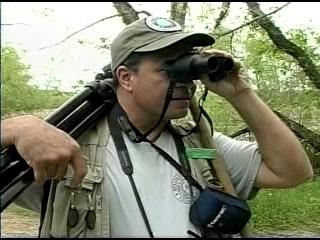
For over 20 years, I've
volunteered at Brazos Bend State Park--almost every week. During
that time, I learned a lot about wildlife there, and at other
places. Once digital
cameras became affordable (for me), I started taking pictures of
what I saw. By now (Year 2025), I've gathered thousands of images
and hundreds of video clips.
I've used many of those on this website. Recently, I realized that
although I'd captured images of Gallinules and Coots--I hadn't
really put many of them onto
the website. So I started this page; first by moving the images I've
already shared on other pages. I've grouped these species together
because they are very close
in size and shape--and behavior. The physical differences are easy
to see when they are next to each other...like on a web page. I
expect to show these three species
on this page: American Coot (Fulica americana), Common
Gallinule (Gallinula galeata) and, Purple Gallinule (Porphyrio
martinica) R. Dashnau 1/28/2025
01/24/2025
A
very cold front left
snow in the area on Jan.
21st. When I visited
Fiorenza Park on Jan.
24th, the snow and
freezing temperatures
were
gone. American Coots are
among the many birds
that live in the
360-acre park. I
watched them feeding on
dead fish which had
probably died during the
freeze. I've
observed Coots feeding
many times here-and at
other parks-and have
always seen them eating
plant matter, such as
seeds or algae.
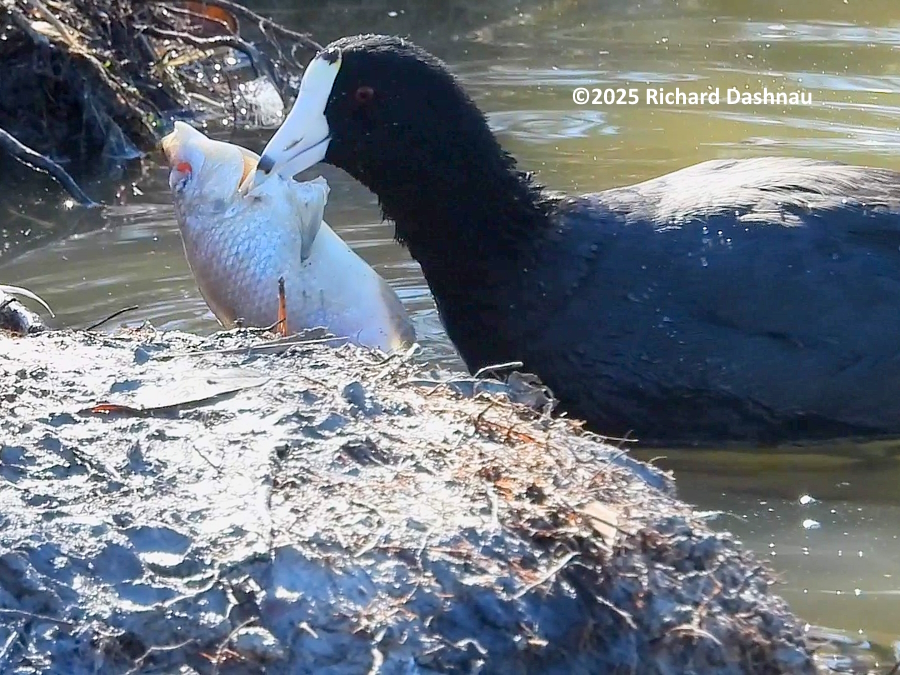
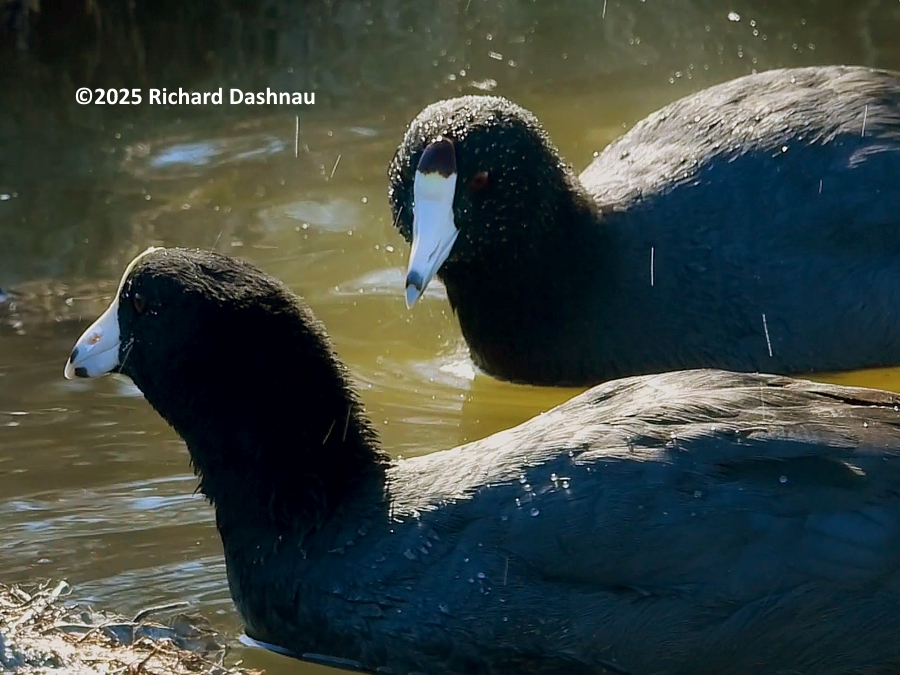
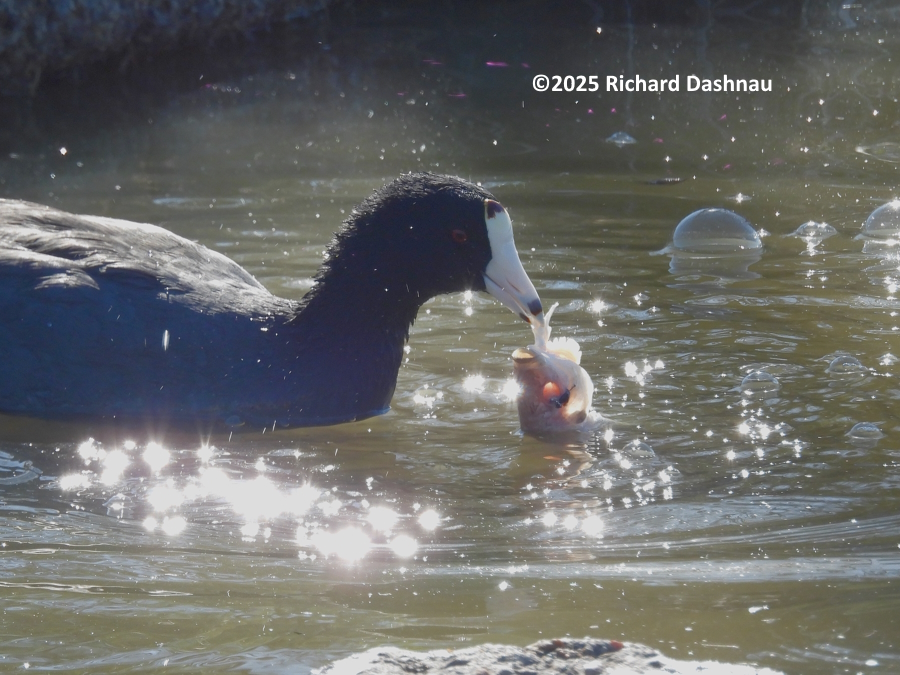

I was surprised to see
the Coots searching for,
and then eating, fish
carcasses.
Some of the images here
are frames from
this edited video.
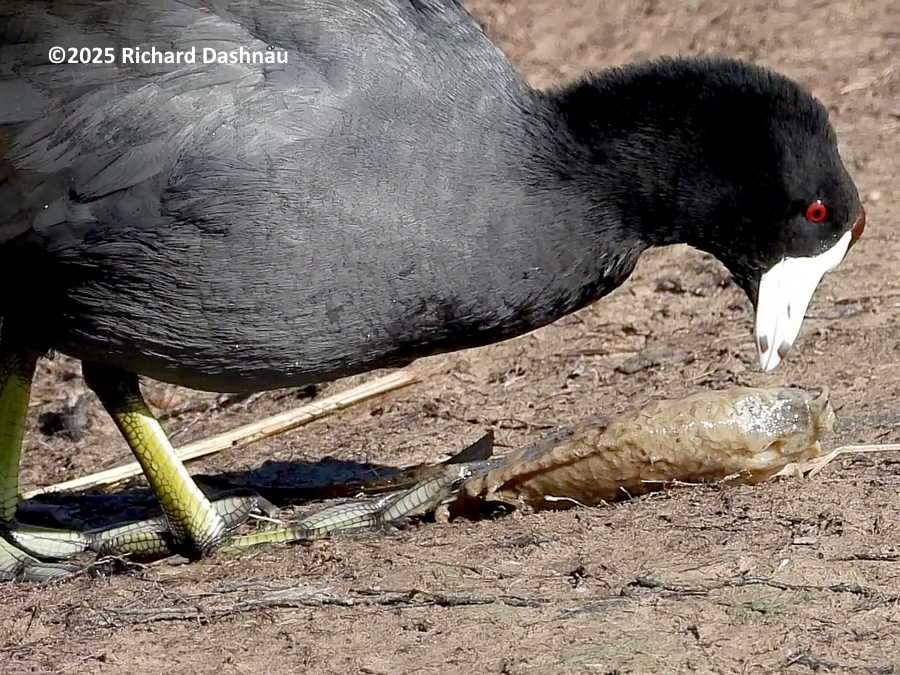
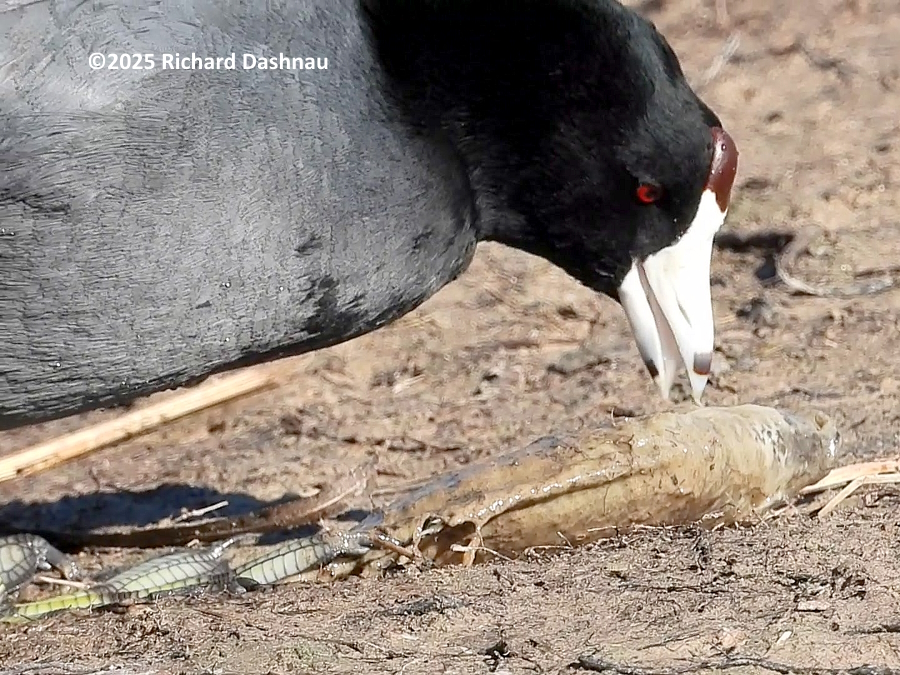
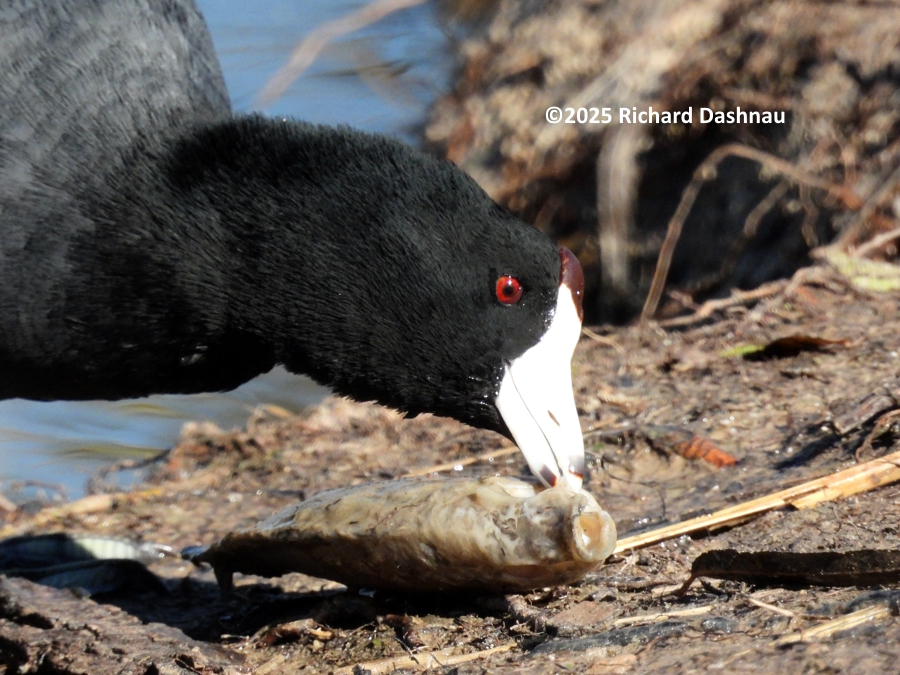
From
BBSP on 06/05/2022
and
07/03/2022 The water level drop in
Pilant Lake has affected all kinds of things. On 6/05, this
Little Blue Heron was foraging for small prey. Meanwhile,
various birds foraged around it, including some Common
Gallinules. I've seen various birds forage near Gallinules (and
their chicks) without alarming the Gallinules. Today, the
Gallinules weren't so indifferent, and they chased the Heron
away. For a second, the Heron seemed a bit surprised at the
challenge from the Gallinules. The video is here(mp4).
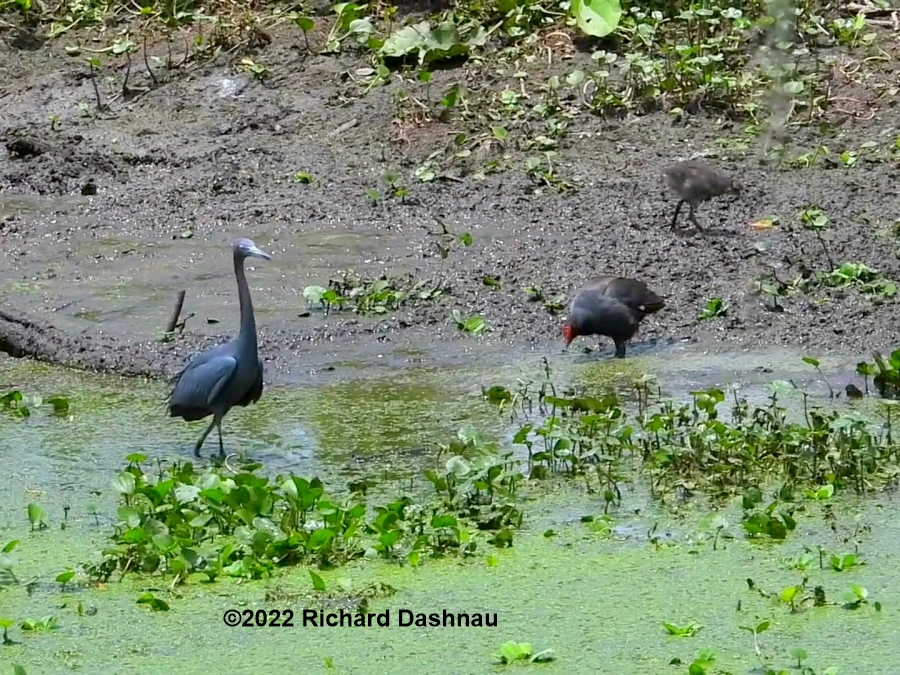
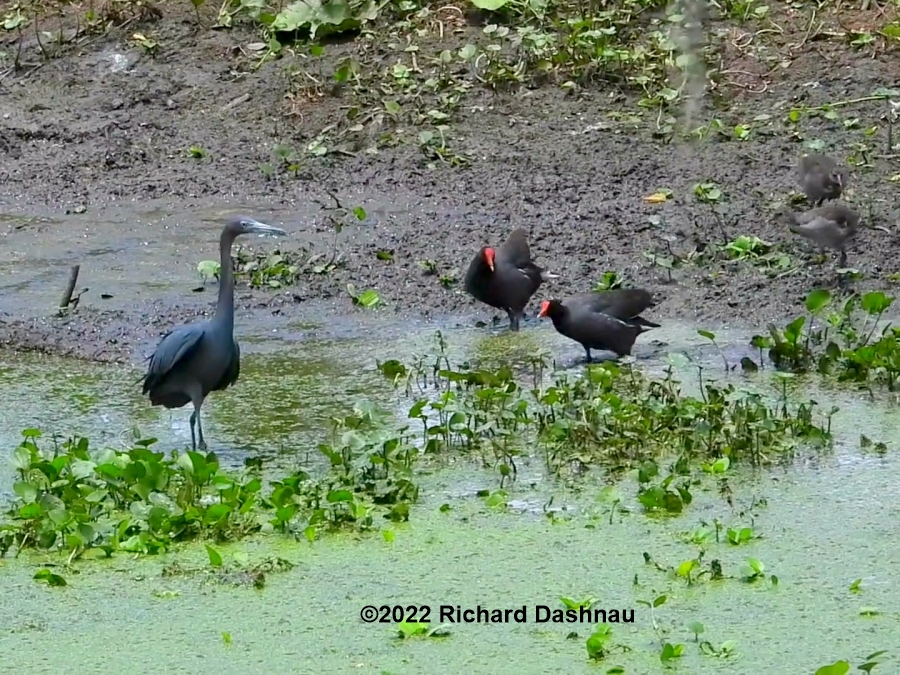
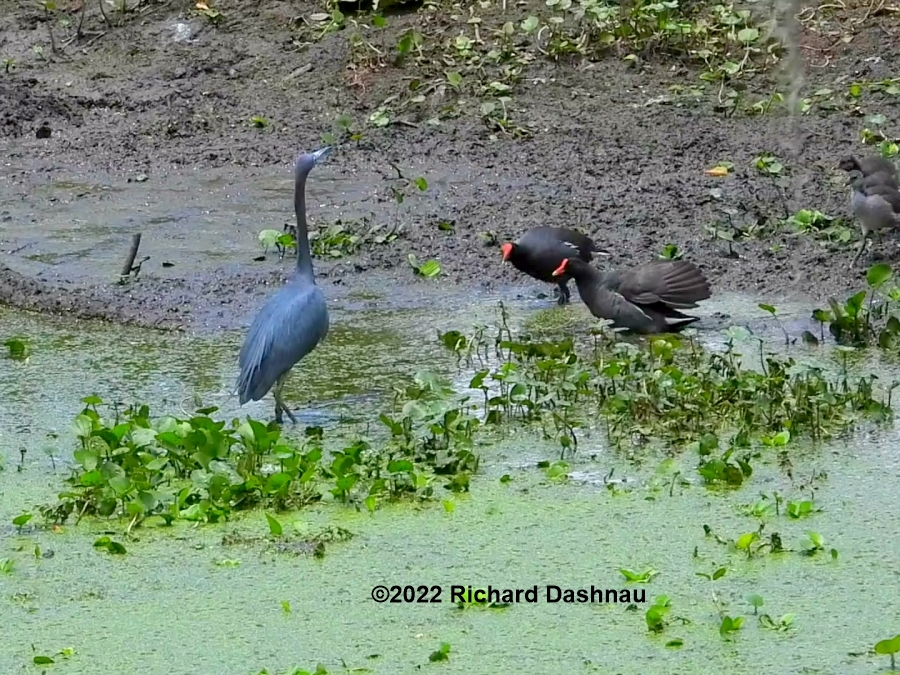
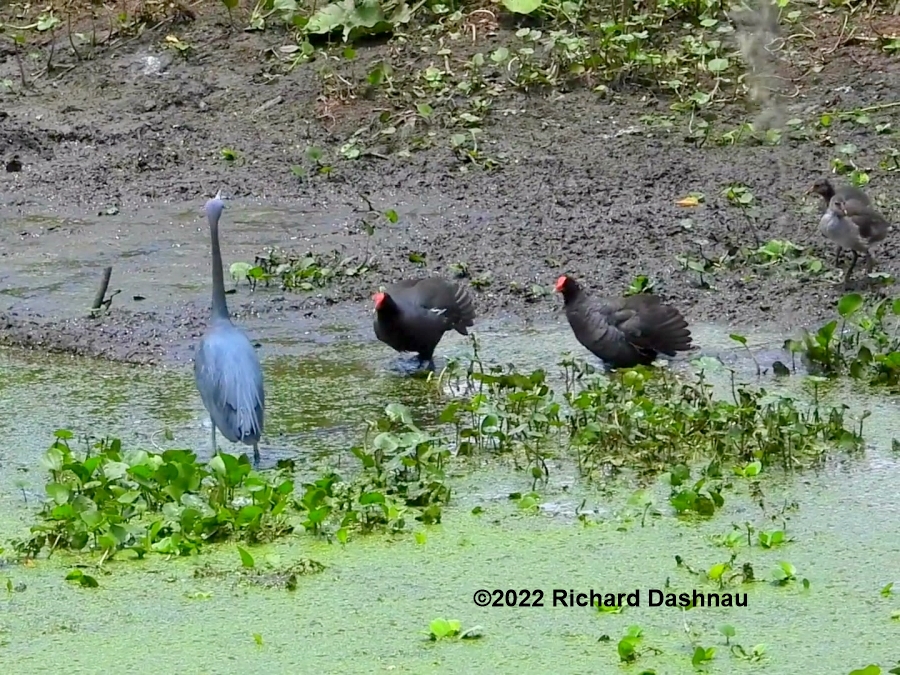
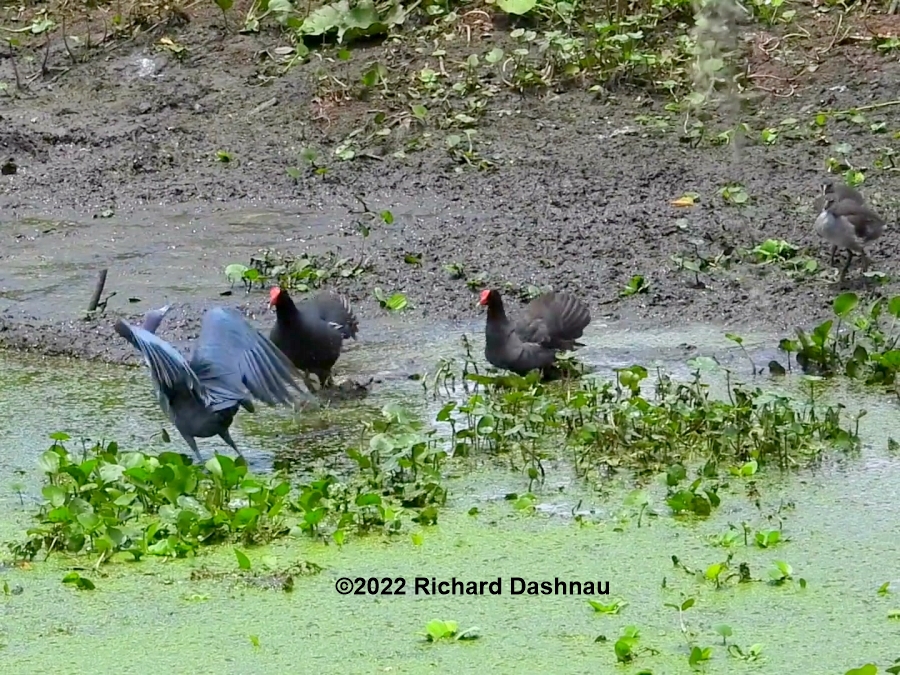
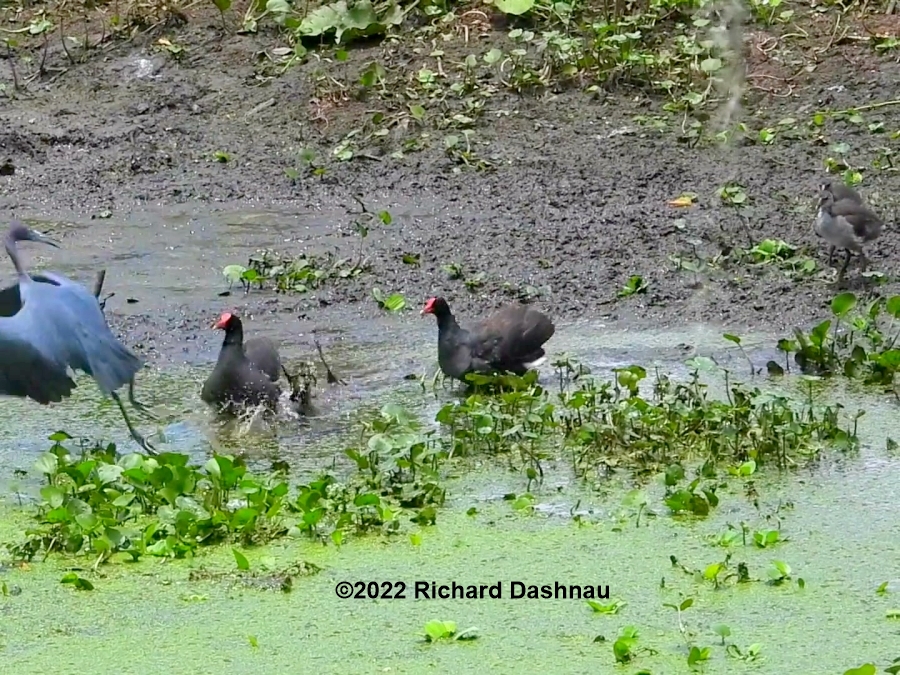
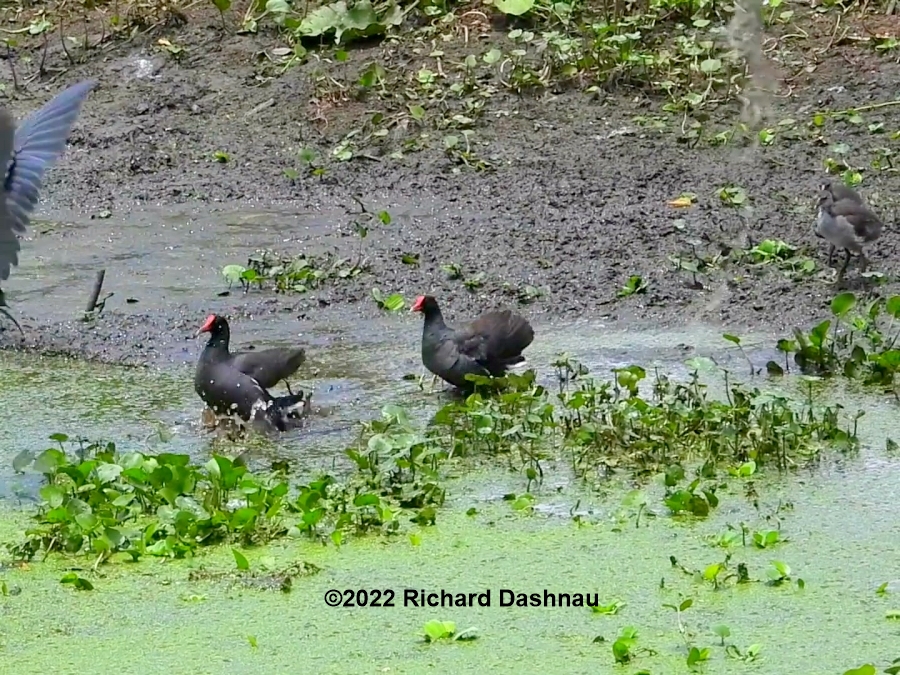
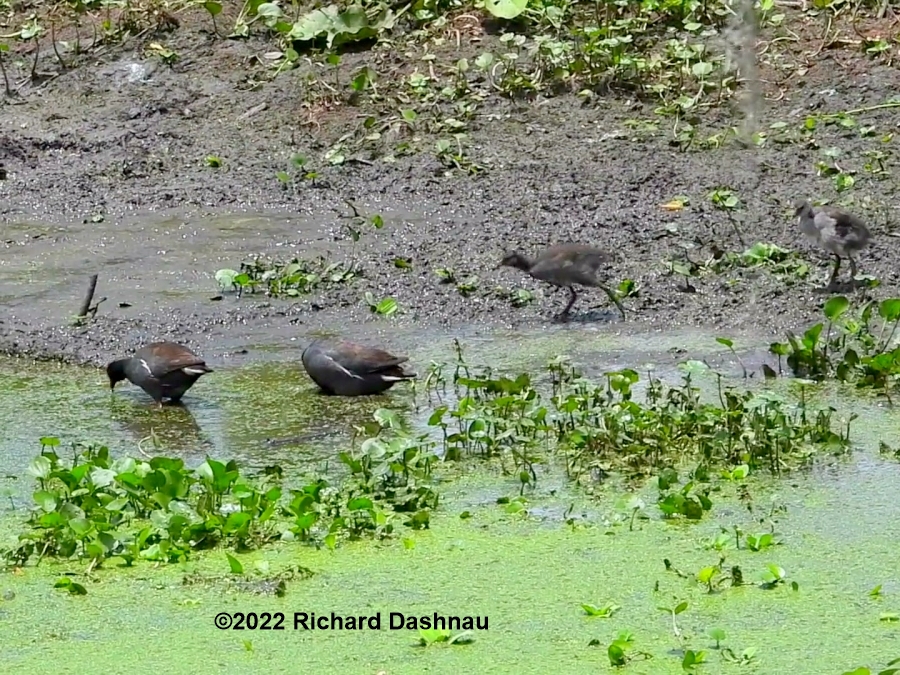
I noticed the chicks walking on
the mud, but they were too far away to photograph. I've been
curious about watching Gallinules using their long toes to
distribute their weight over various
substrates. On 7/03, I was able
to get a close look at Gallinule walking on the mud in Pilant
Lake. The video of this one walking, and the others
chasing the Little Blue Heron are in a video
and the
video is here(mp4). The
images
above are frames from the video. There are more images and
more detailed examination on one of my ichnology pages.
10/31/2021 I had a busy day, because a lot
was going on by the Observation Tower that day. For now, I
also have this mystery to share:
9:00am I was near the Observation Tower, facing North, and
talking to a visitor. Sudden commotion to my right caught my
attention. From the corner of my eye, it seemed like a typical
"disagreement"
between gallinules and/or coots. If you haven't
visited the park, then try to imagine being surrounded by
the sounds of various birds calling and splashing all around
you. Not every
day at BBSP is
like that, but today, the birds were active. After a
while, one stops turning to investigate every little
commotion--because they are everywhere. This time, there was
some gallinule calls, and splashing.
When I turned full attention towards it, I was able to see just
the ending. I had the impression of something large at the
surface (of course, I thought "gator"), but then the event
was over.
When the water became still, all that remained was a single
Common gallinule (Gallinula chloropus). It was obvious
that the bird had been attacked by something. It did not float
as gallinules usually do.
It was in the deeper water, centered between the tower and the
island. It began swimming towards the tower.
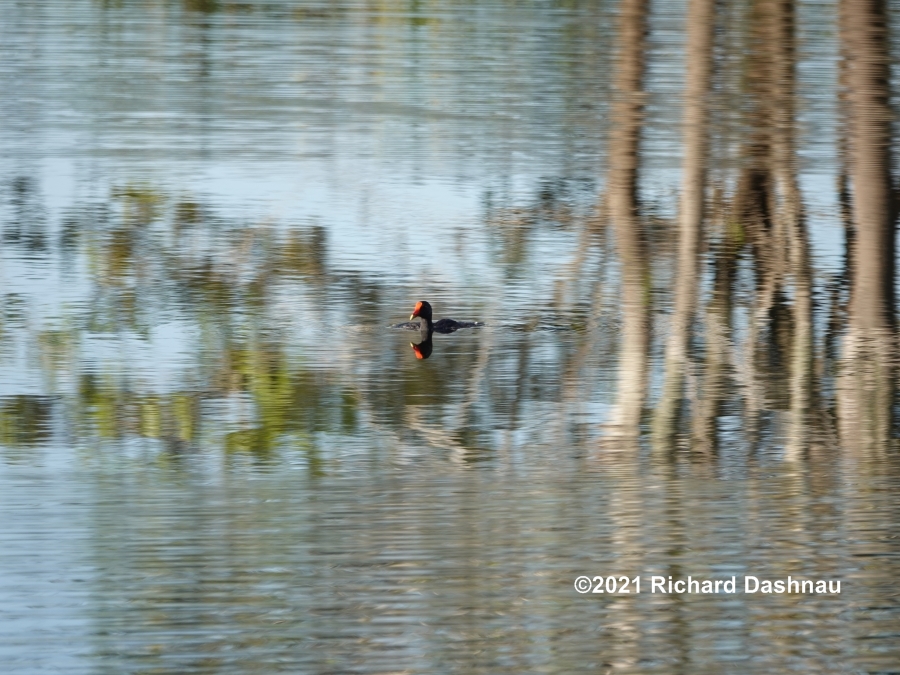
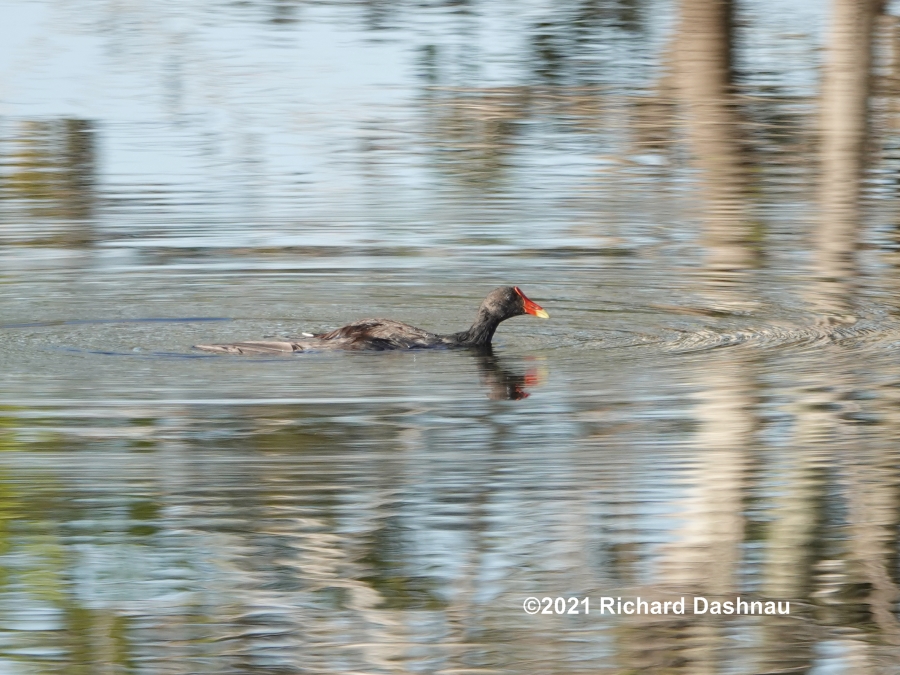
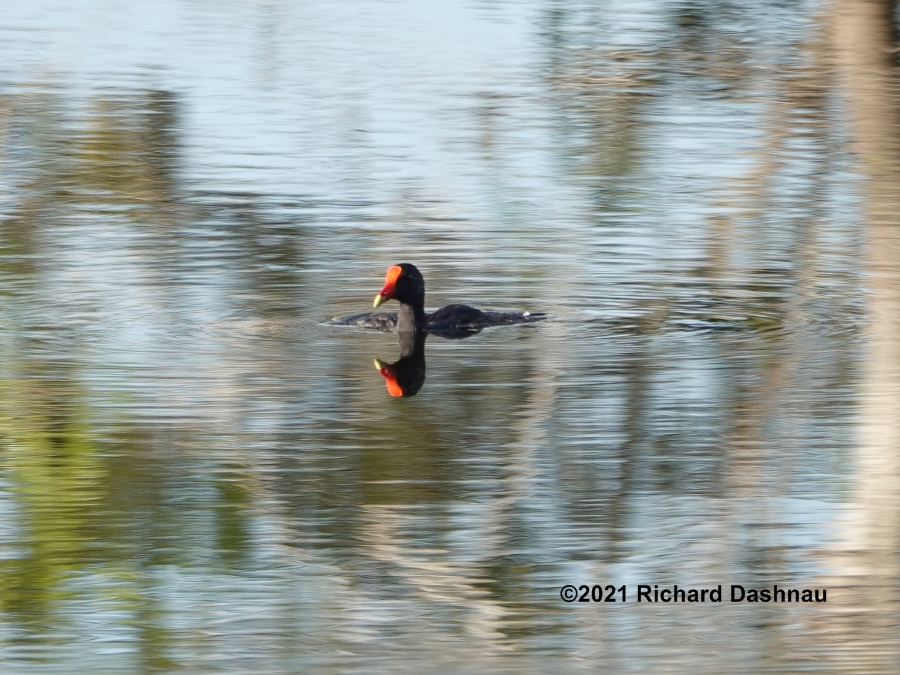
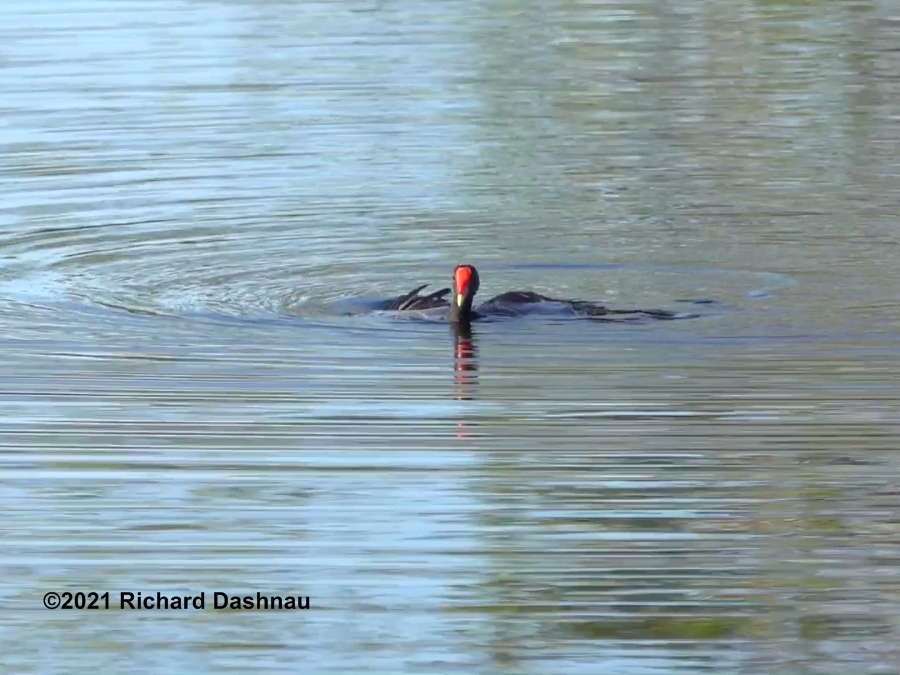
But it remained mostly submerged, and so did not move
properly-using its wings to "breast-stroke" slowly through
the water instead of paddling on the surface. I scanned the
water around it. If an
alligator had attacked the bird, I expected at least to
see one surface nearby. No alligator appeared near the
gallinule. It was also strange that whatever had attacked
the gallinule did not return
to attack the bird while it moved slowly towards us. My
only other guess is a large fish-perhaps a gar-had attacked
it. Although it wasn't floating or swimming properly, the
gallinule didn't act
stressed or frantic. I shot video while the gallinule was
swimming to show its condition. That video is here.
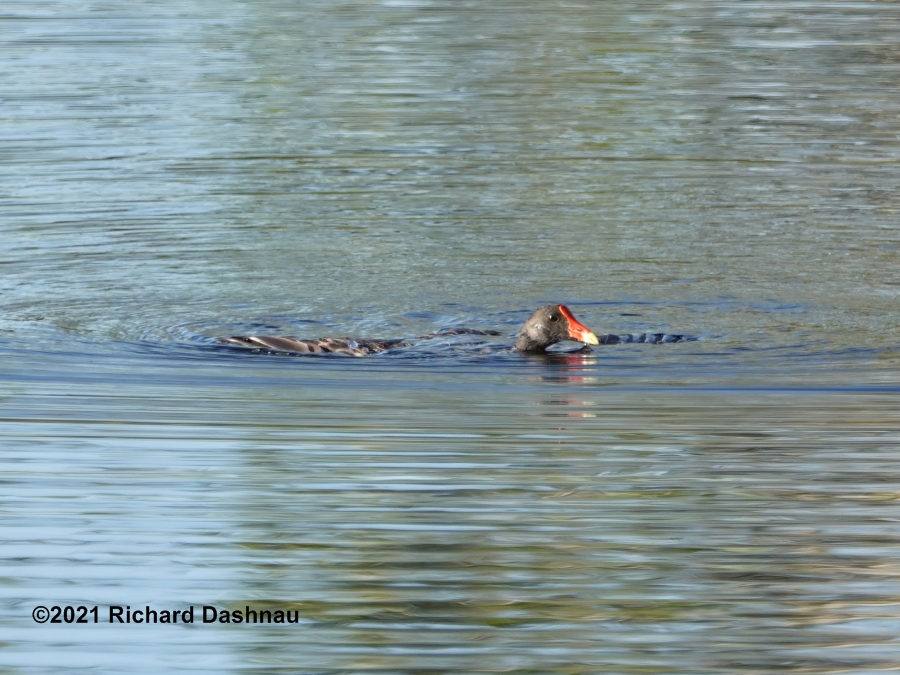
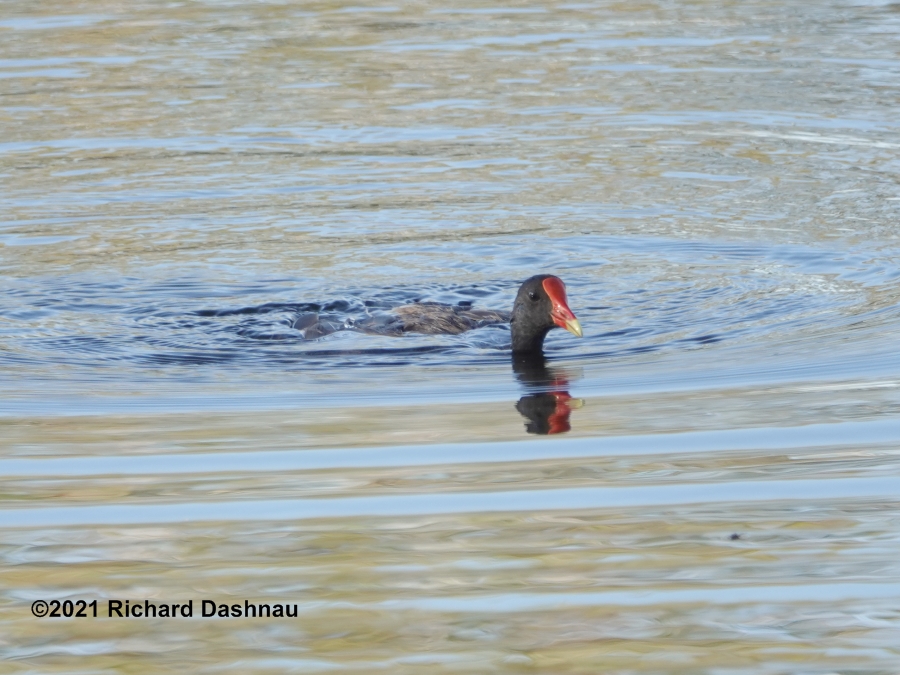
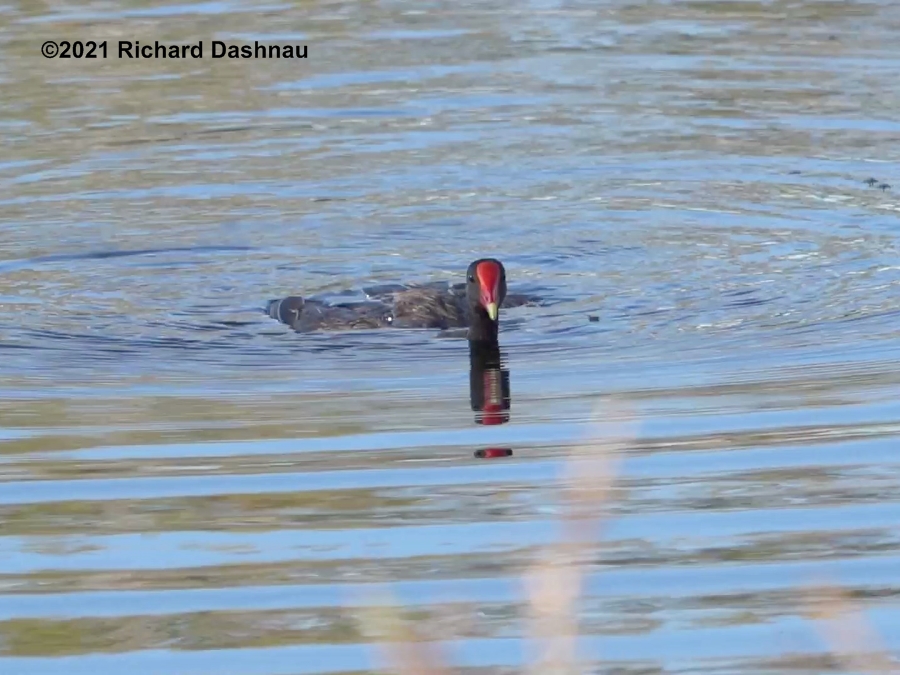
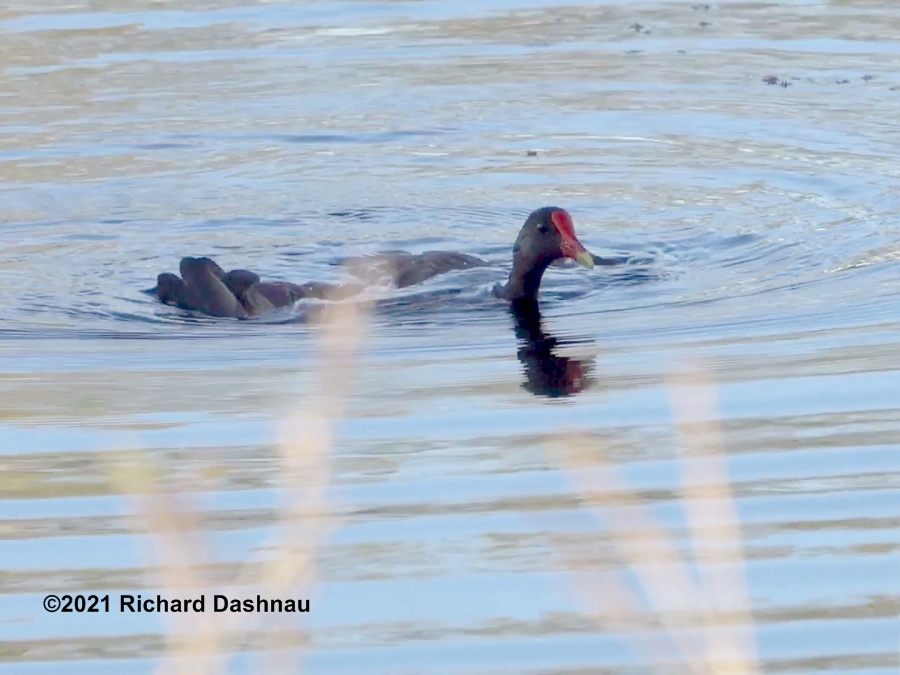
In any case, the gallinule eventually made it to the branches of
a small snag under the Oak Tree. It rested there, and I moved
off to another part of the trail--but where I could still watch
the branches.
I walked over to check a few times, and the gallinule had
climbed partially onto a branch--but it never stood up. I'd
hoped it would recover, dry off, preen, and swim away. It
didn't do any of that.
I stayed away from it, and didn't mention it to visitors, hoping
to avoid stressing the gallinule. If someone noticed gallinule
and asked about it, then I explained what had happened. I never
took any
pictures of the gallinule among the branches--mostly because
among the branches it was pretty hard to see. After
some hours, I checked on the gallinule one last time, and saw it
floating upside down.
It had apparently died.
11/10/2019
(uploaded
2/04/2025)
At Brazos Bend State
Park, this American Coot burst into a water-surface
run from a floating position. The images are frames
from a video, and
the video is here.
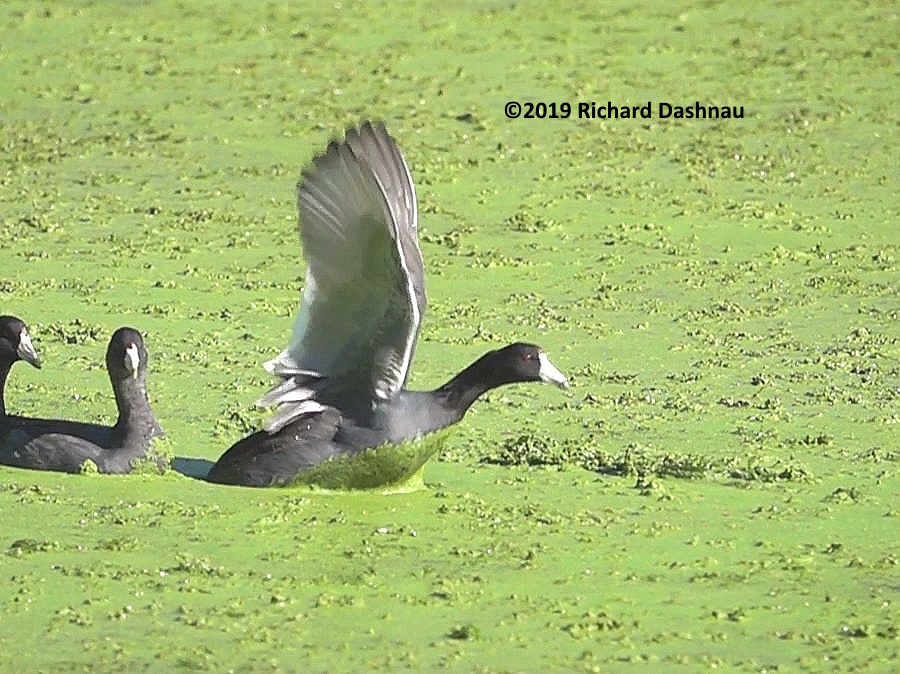
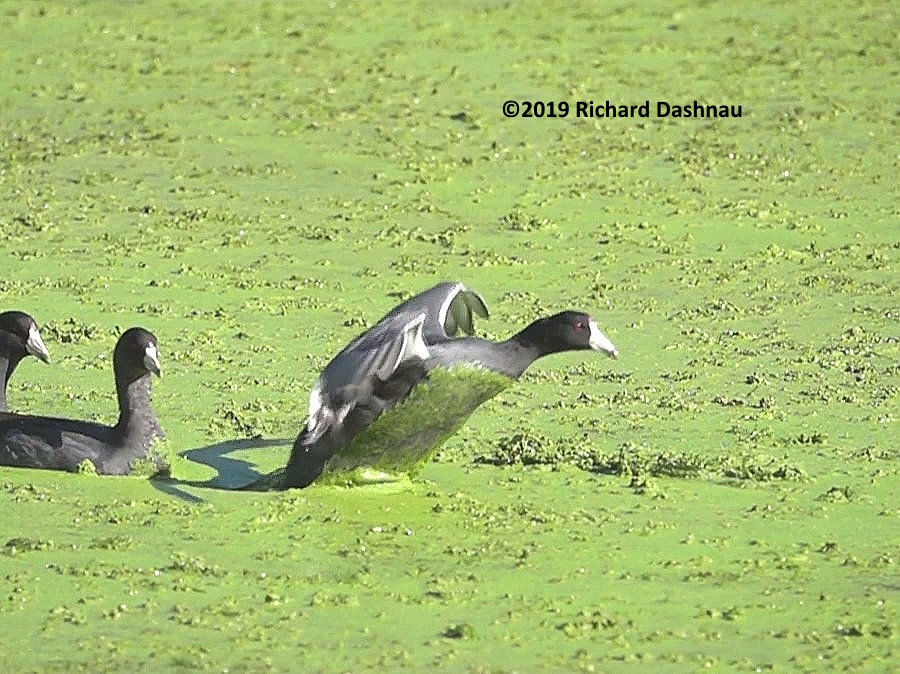
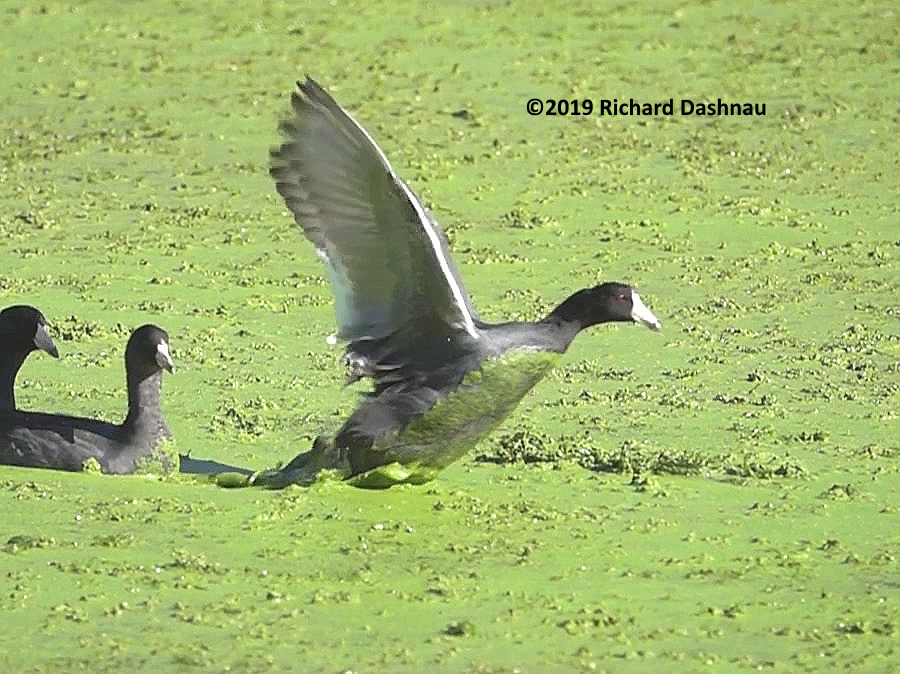
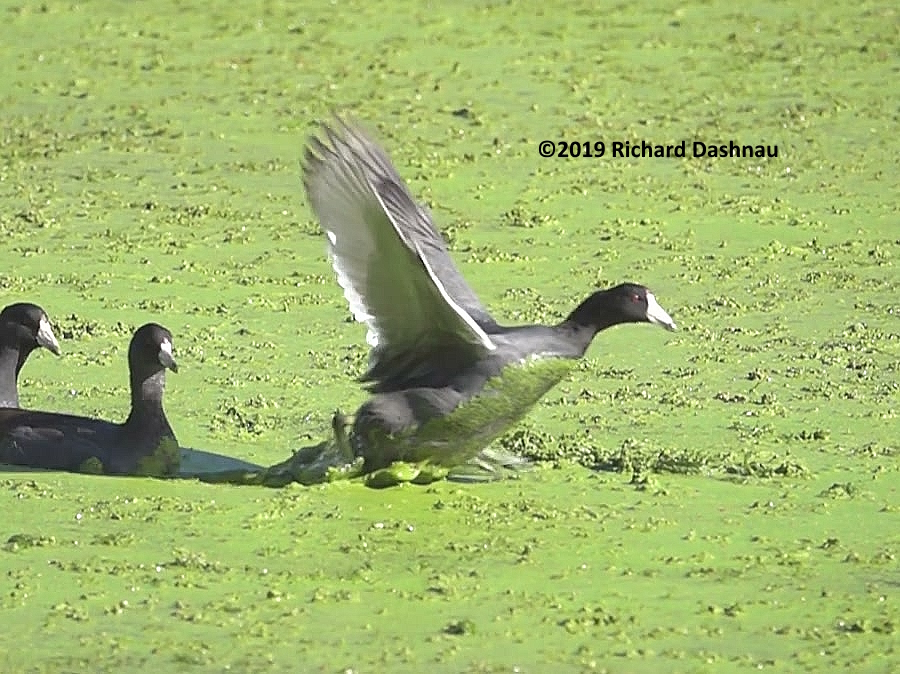
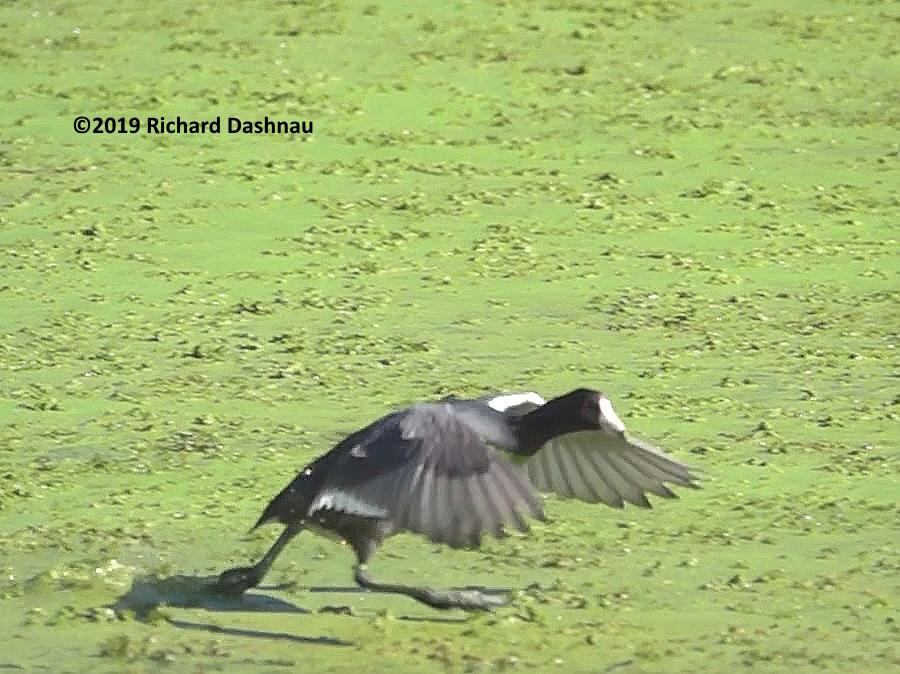
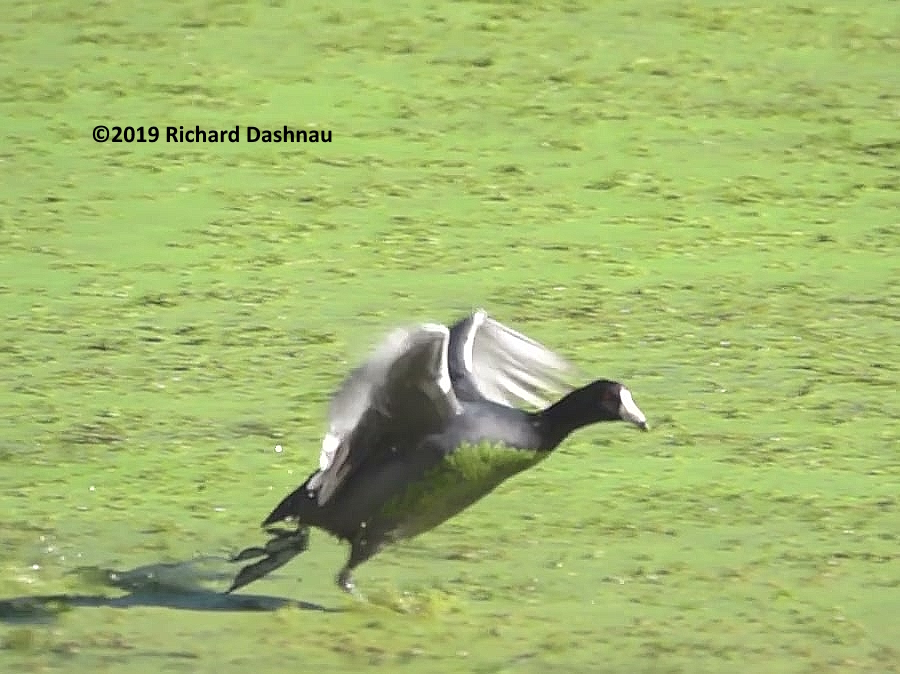
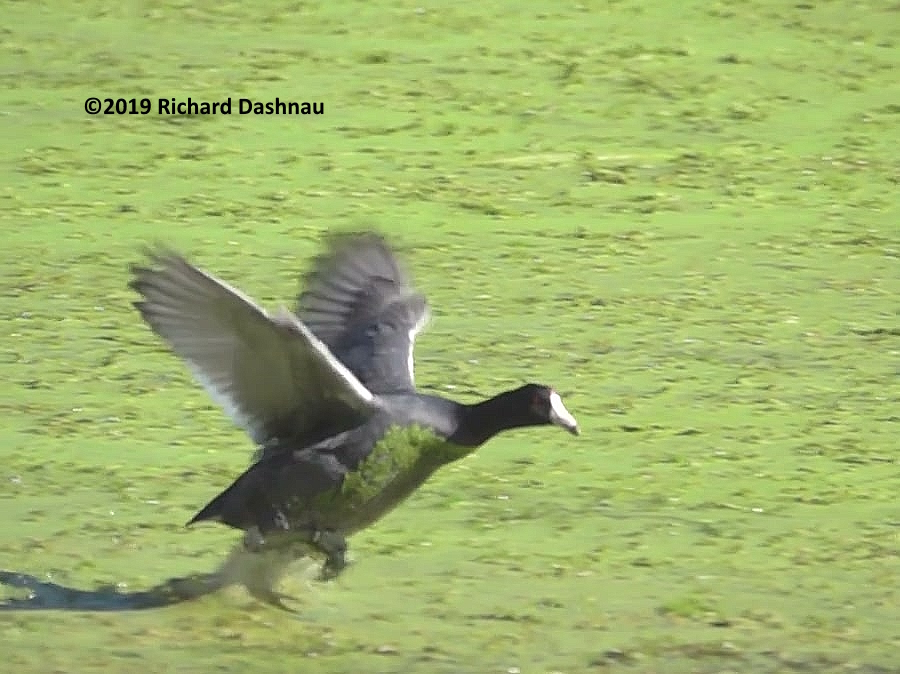
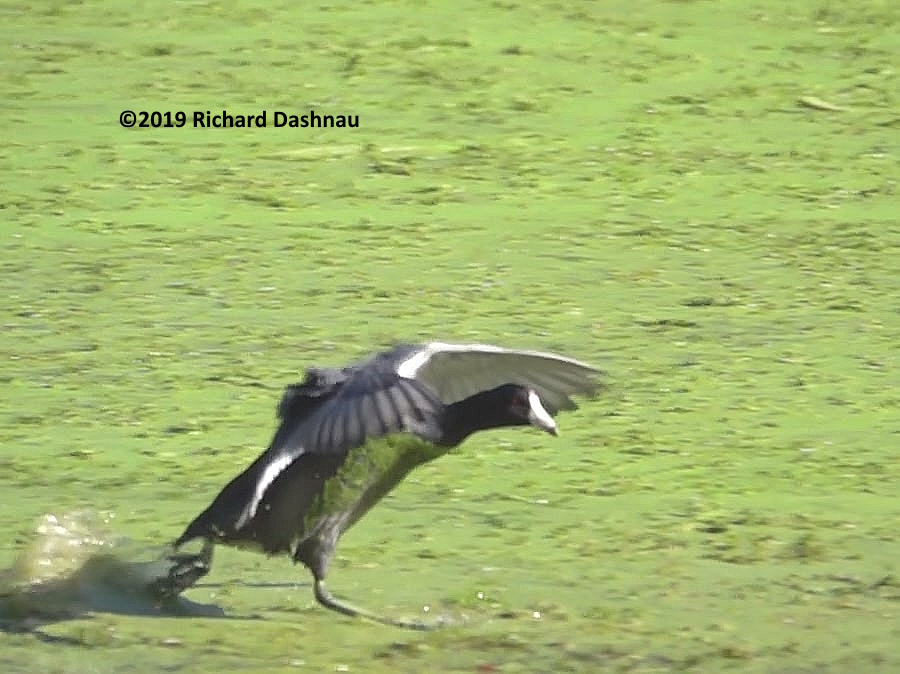
07/01/2018 This
is
a pair of Common Gallinule (sometimes called Moorhens) with
chicks. The young chicks look interesting with their claw
like, undeveloped wings. The images below
are frame grabs from this
video clip showing an adult with chicks. Notice the
really, really long toes, which help them move over plants and
mud without sinking.
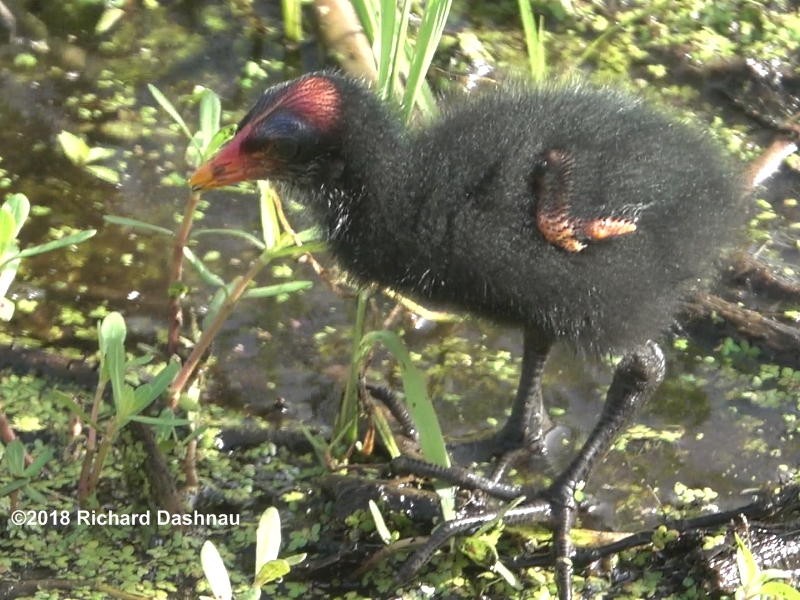

COMMON GALLINULE CHICK
03/17/2018
(uploaded 2/01/2025)
This conflict at Fiorenza Park
had started before I found it. The video was filmed at 480fps
and slowed 16X. I have often seen Coots chase each
other, but this was the first time I'd seen them slapping each
other with their feet. I've seen Common Gallinules fight this
way once in 2011. Another Coot joined in the fight
in
progress. But the target Coot didn't seem to care. Those amazing
wide toes, great for swimming, are apparently useful for
slapping, too. Just 50 seconds later, one of the Coots had
left. After the last face-off, the remaining 2 also left.
This camera captures 2 seconds at 480fps. There was a pause as
the video was written to storage before I could record the next
2
seconds. This leaves gaps in recorded events. The video is here.
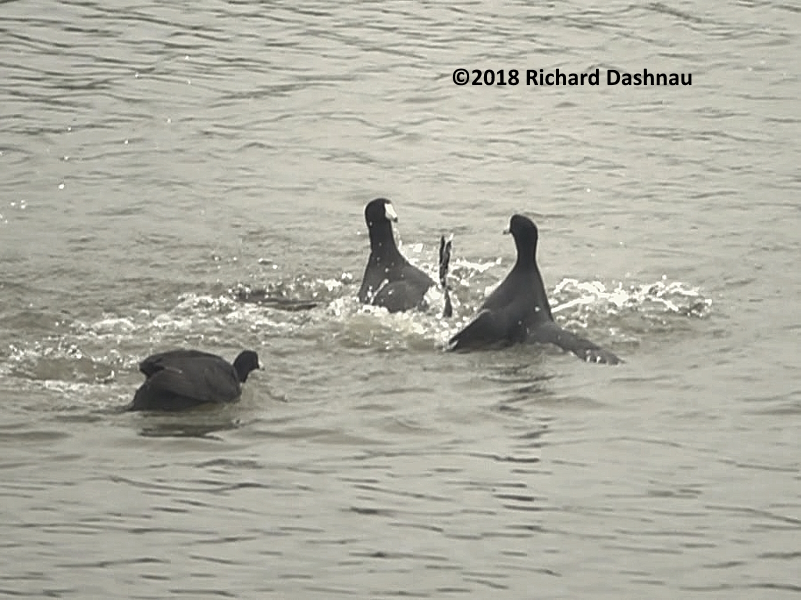
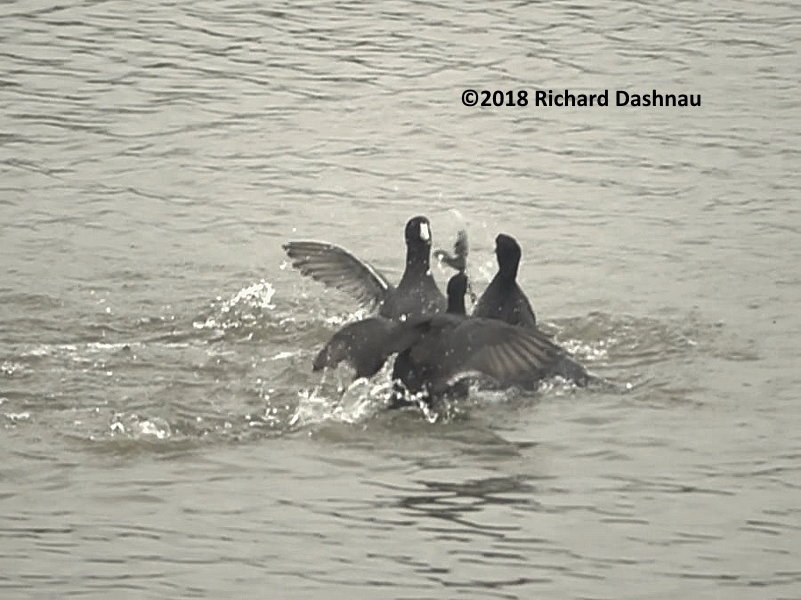
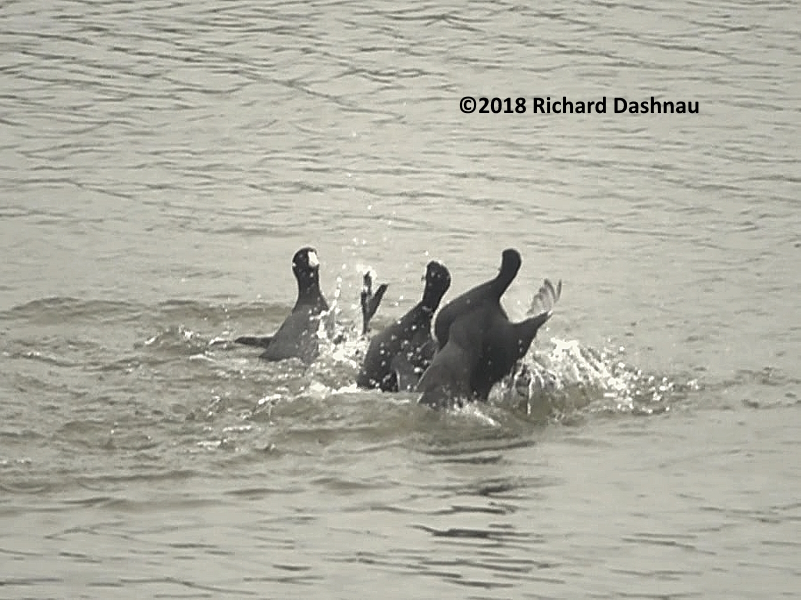
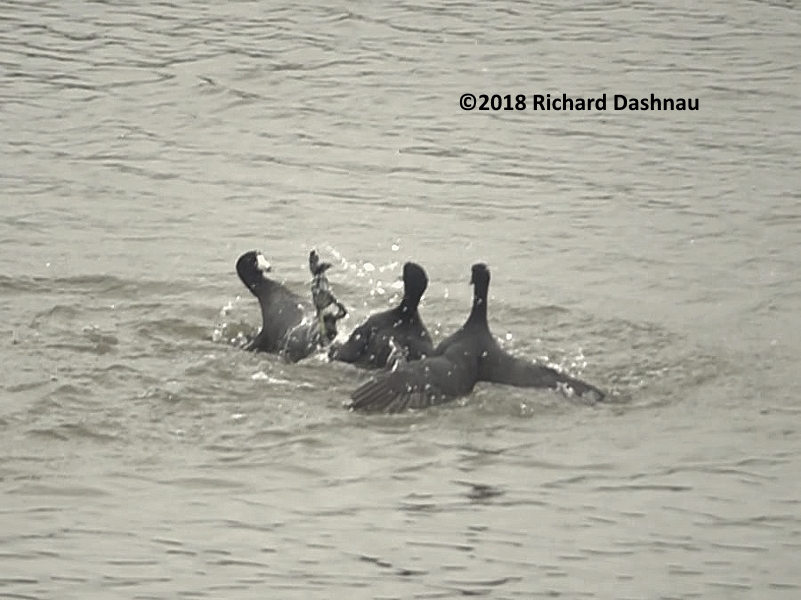
11/19/2017
(uploaded 2/01/2025)
Another example of a Coot taking
off and running across the water surface; filmed at 480fps and
slowed 16X. In this case, the Coot launched and--
supported also by wings--seemed to start out with just the tips
of its toes grabbing the water. The Coot's body was clear of the
water. The feet started out making large wide
splashes,
with no "secondary" plumes. As the run continued, the Coots feet
sunk further into the water. This generated the secondary water
plumes a step behind the coot. Wonderful view! For
short distances, this combined flight/run is probably more
efficient than taking off into full-flight and landing a short
distance away. The video is here.
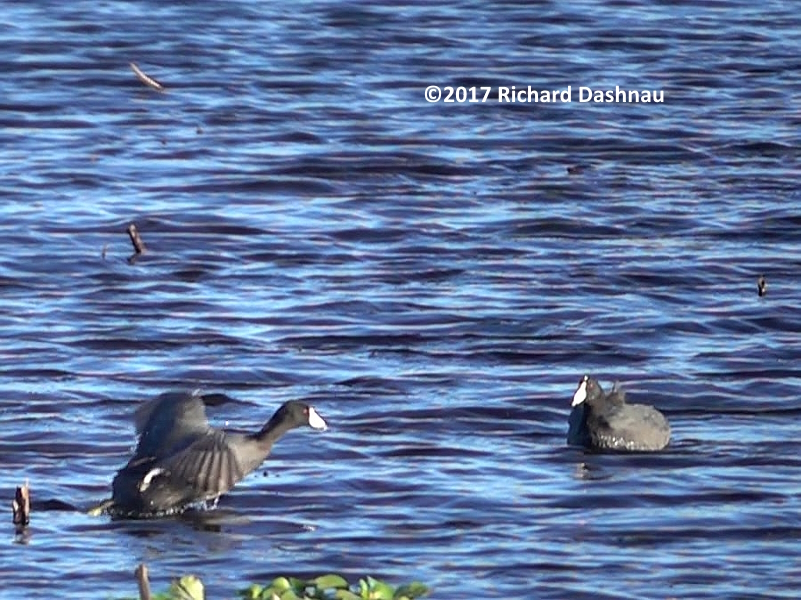
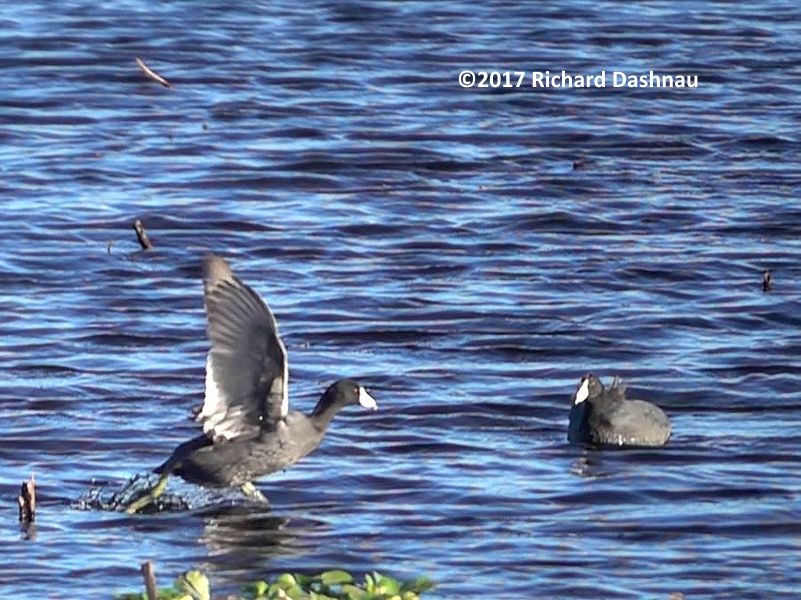
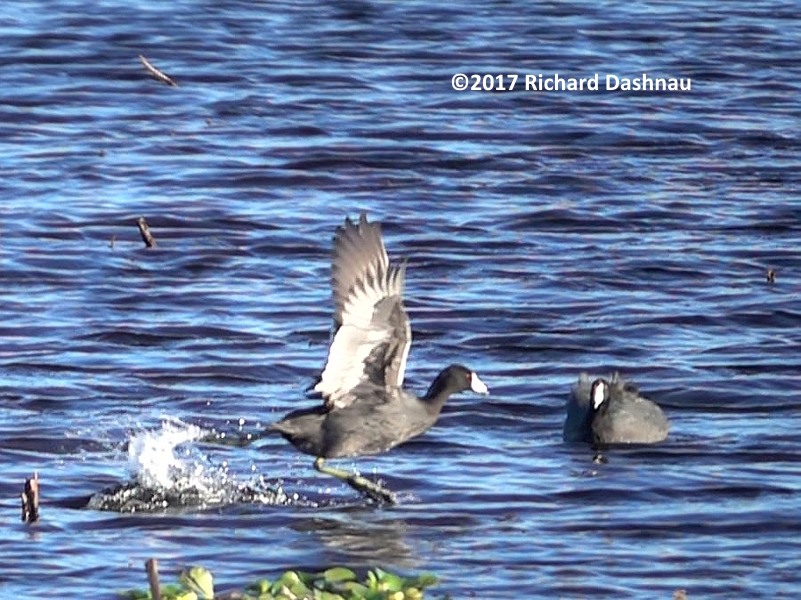

01/08/2017
(uploaded 1/31/2025)
Here's a slow motion view (slowed
16X) of an American Coot taking off and running across the
surface of a lake. I think the plumes erupting
behind the Coot as it runs were from water rushing into voids
produced by the footsteps. (Imagine a lot of small people doing
"cannonballs" into the water.) The video is here.
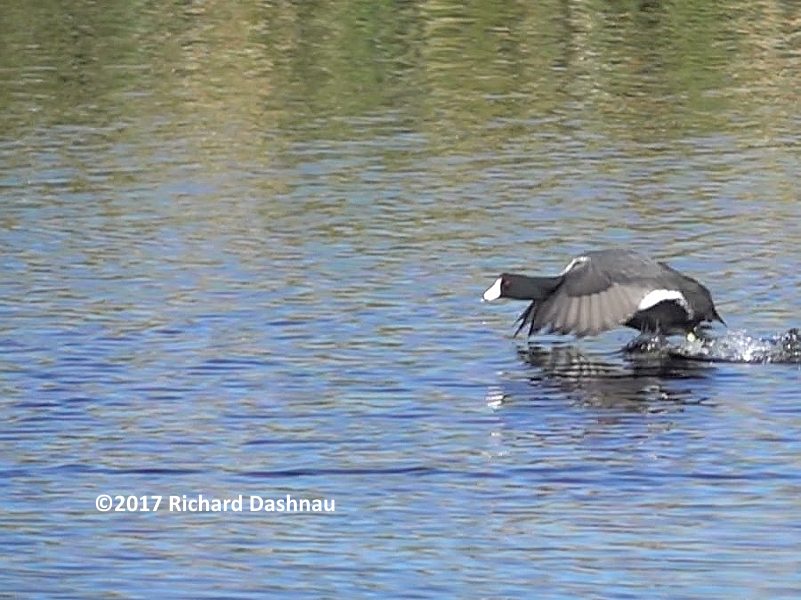
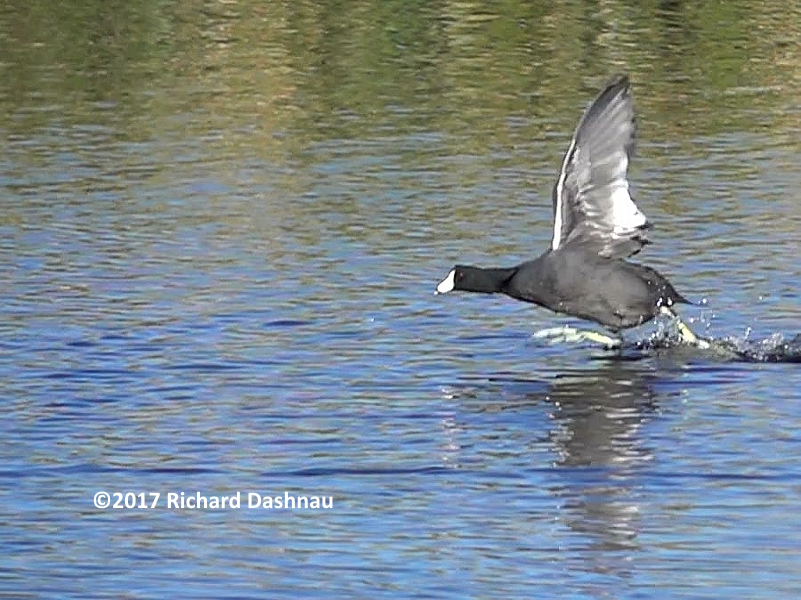
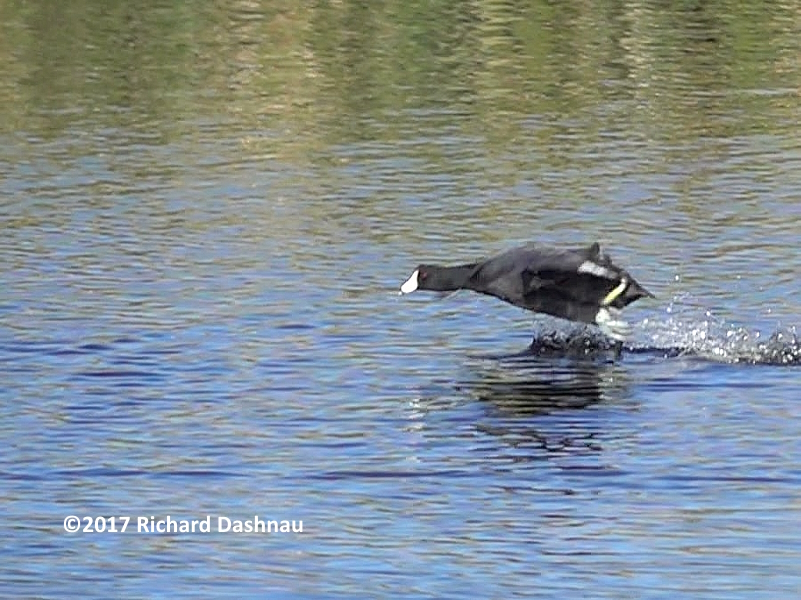
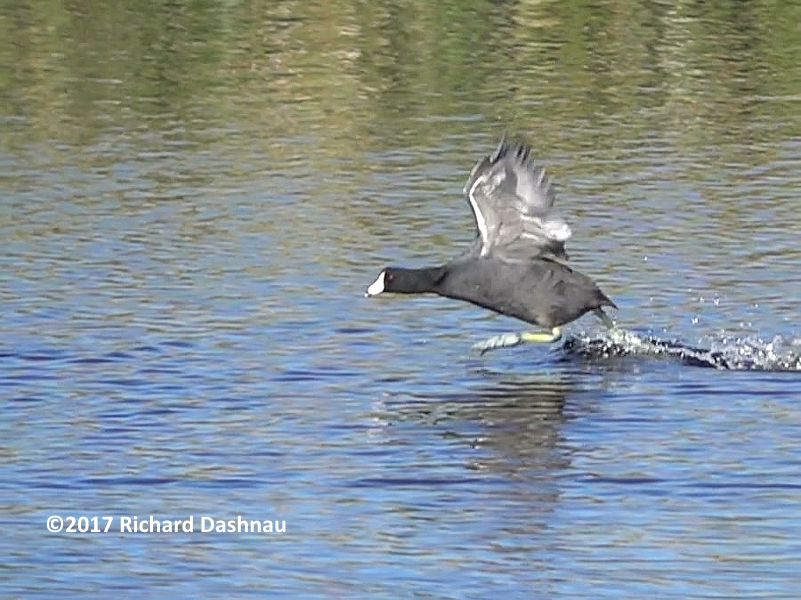
April 12 and 26 and May 3, 2015
(These are photos I shot in 2015, but I'm posting them today,
10/18/2019.) These
are various shots of the very pretty bird species, the Purple
Gallinule
(Porphyrula martinica).
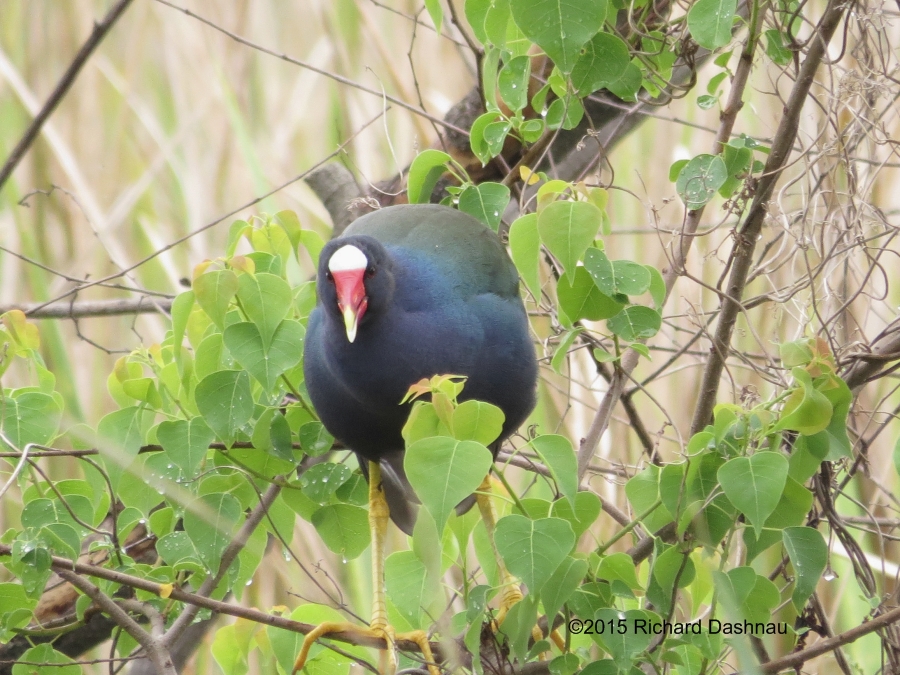
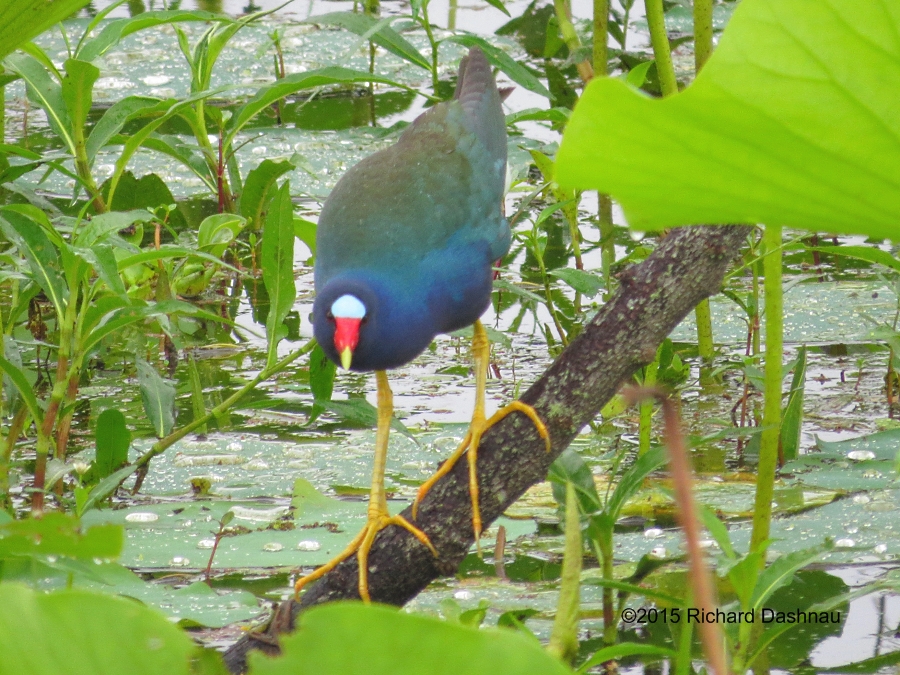
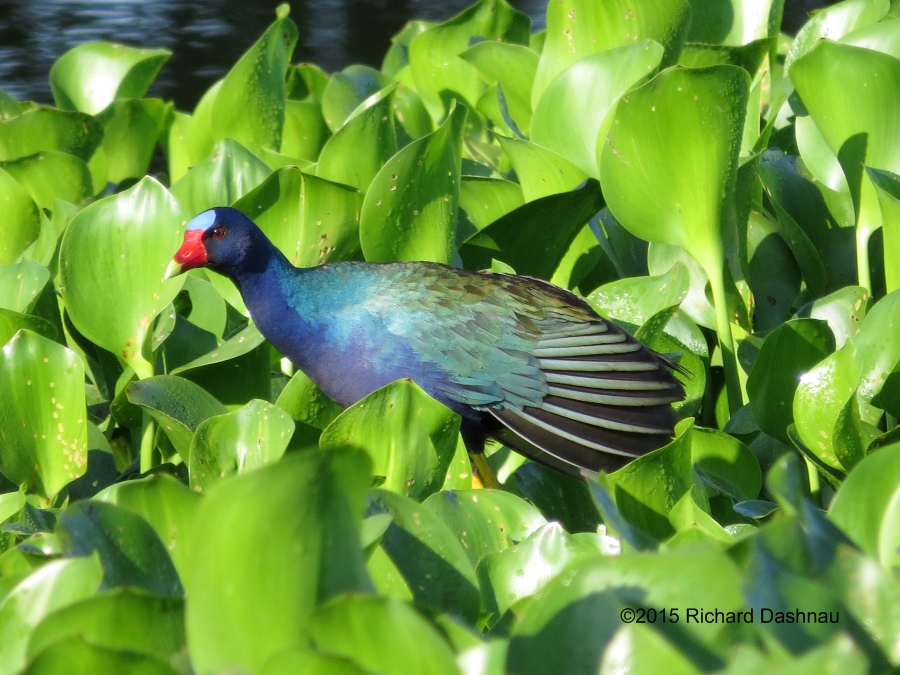
03/06/2011
(uploaded 1/30/2025) These Gallinules were next
to one of the islands in Elm Lake. I was on the trail, about
50 yards away. It was hard to tell what was going on, so I
filmed
at 210fps so I could slow it down. Although not
the best quality video, it still shows this interesting "slap
fight". Their ridiculously-long toes are good for weight
distribution over flimsy
surfaces. They also seem to be very good for slapping,
non-fatal hits during territorial fights. I missed the
beginning of this argument, since I only noticed it because of
the commotion
of the conflict. When the loser backed off and turned
away, it was bitten and chased, as it ran into dense
cover. The
short video of the fight is
visible here.
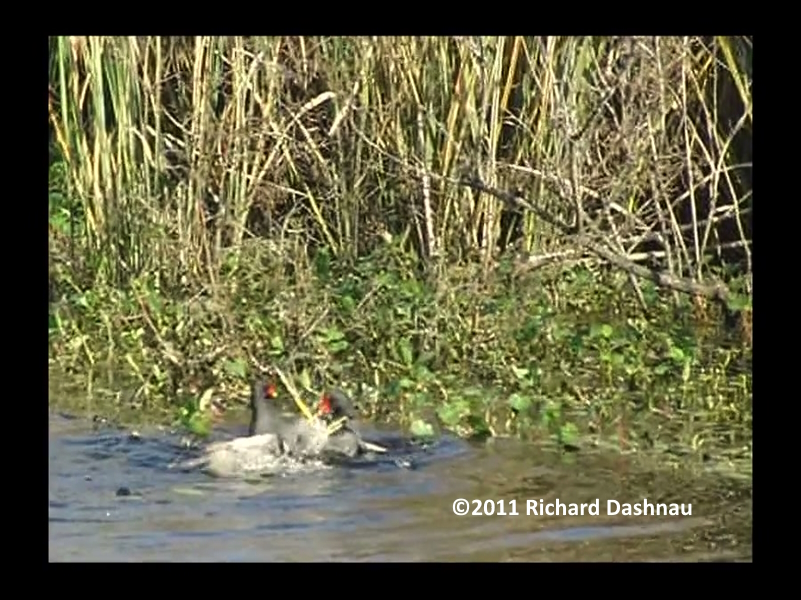 -
-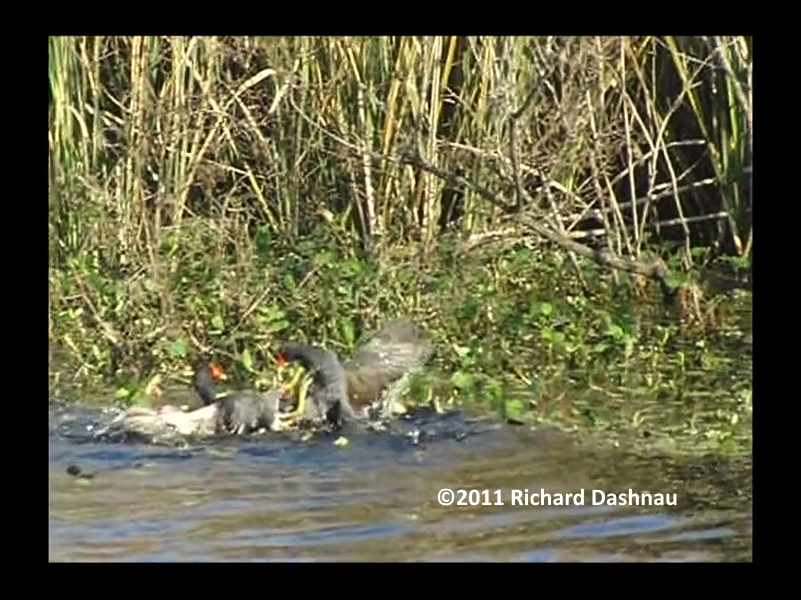 -
- --
--
On
the same day, this Coot was
foraging below the Spillway Bridge, and
allowed me to stand and watch it. The light
was just right, allowing me to see into the
water. We can see those amazing
wide toes at work, propelling the Coot
along. They fold to allow moving forward,
then open while pushing. Since the Coot is
bouyant, it quickly pops back up to the
surface when it stops
swimming down. It surfaced with a mass
of algae, and quickly consumed it.
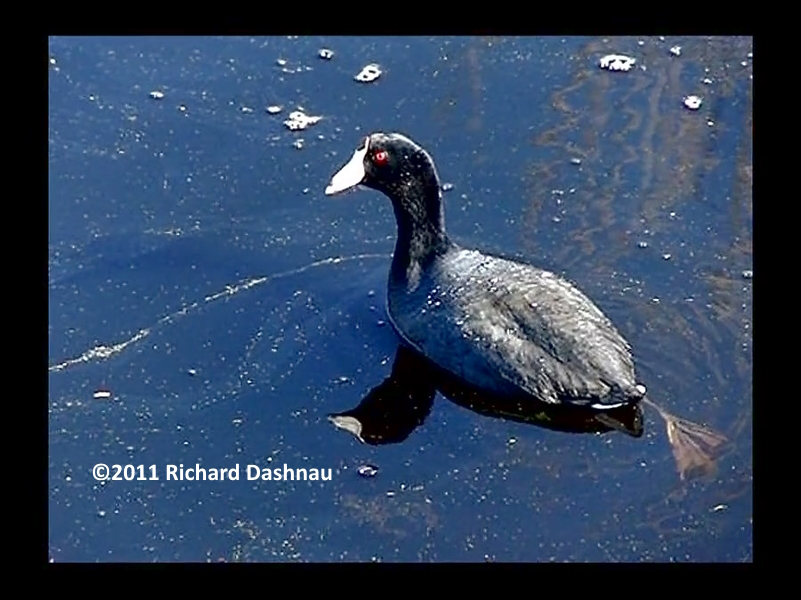 -
-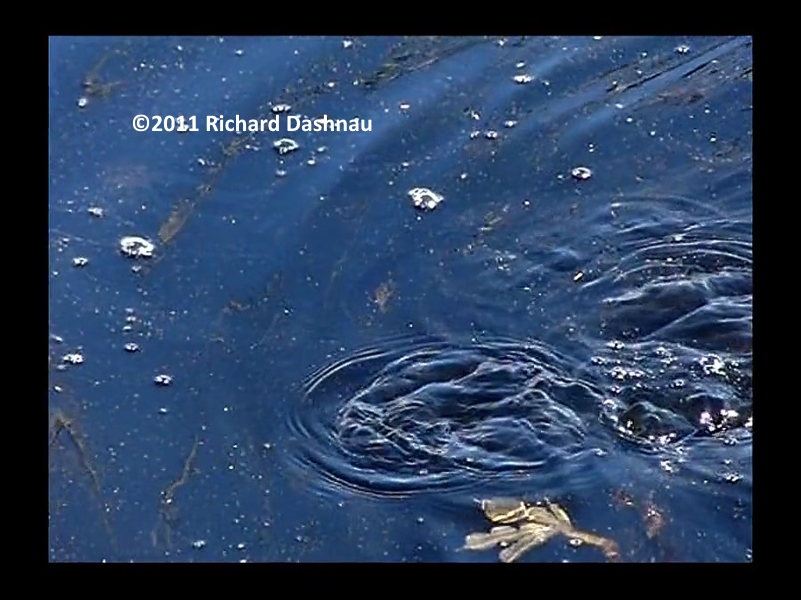 -
-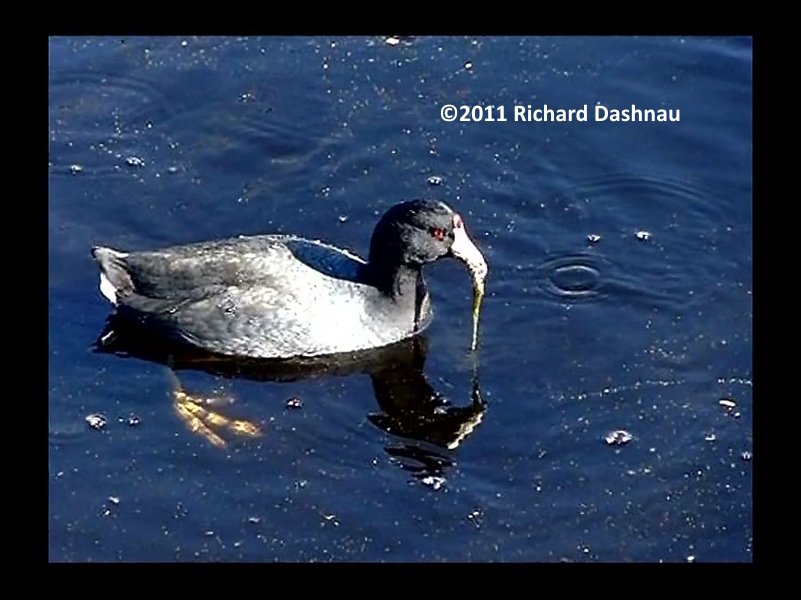
The Coot moved closer. It seemed to be
comfortable with me standing on the
bridge--although it did still check on me.
The Coot seemed to be looking through the
water to search for food
down at the bottom-and then dived for
it. It bobbed right back up. Note how
the feathers repelled the water as it Coot
carried another large mass of algae. The
Coot shook the droplets off. Watch
how its feet push straight down and help
lift its body out of the water. I left
the Coot as it continued to graze. The edited video is here.
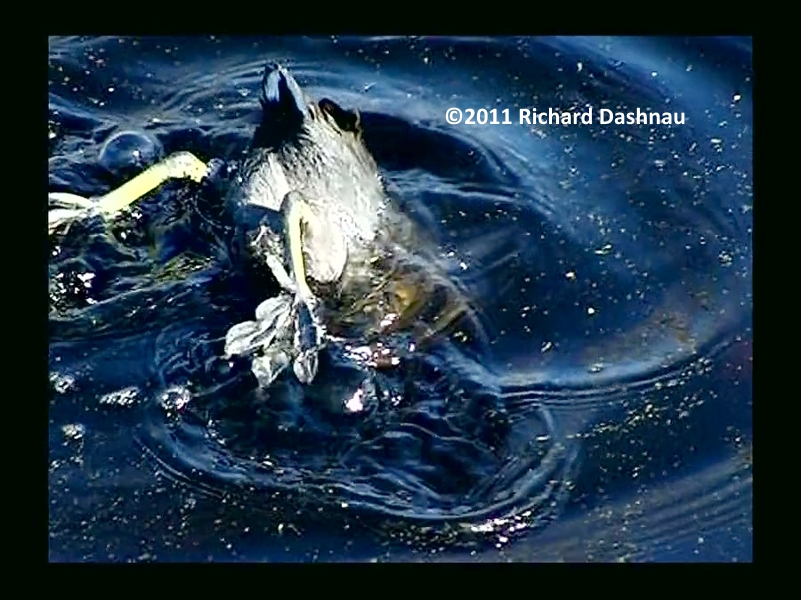 -
-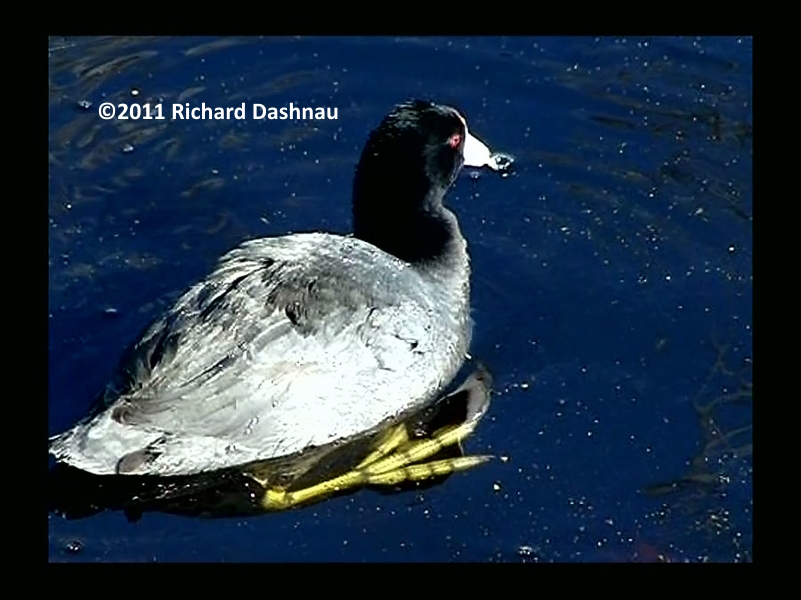 -
-
11/08/2009
(uploaded 1/30/2025)-- When the water is high, and
open, the Coots form huge mats. They swim together, but
sometimes-instead of swimming, or flying-they run to the
next point of interest. Instead of all running together, the
Coots run in smaller groups. When the first group starts, it's a
good chance to anticipate the next one. So I was ready to
follow a few of the Coots as they ran across.
 -
-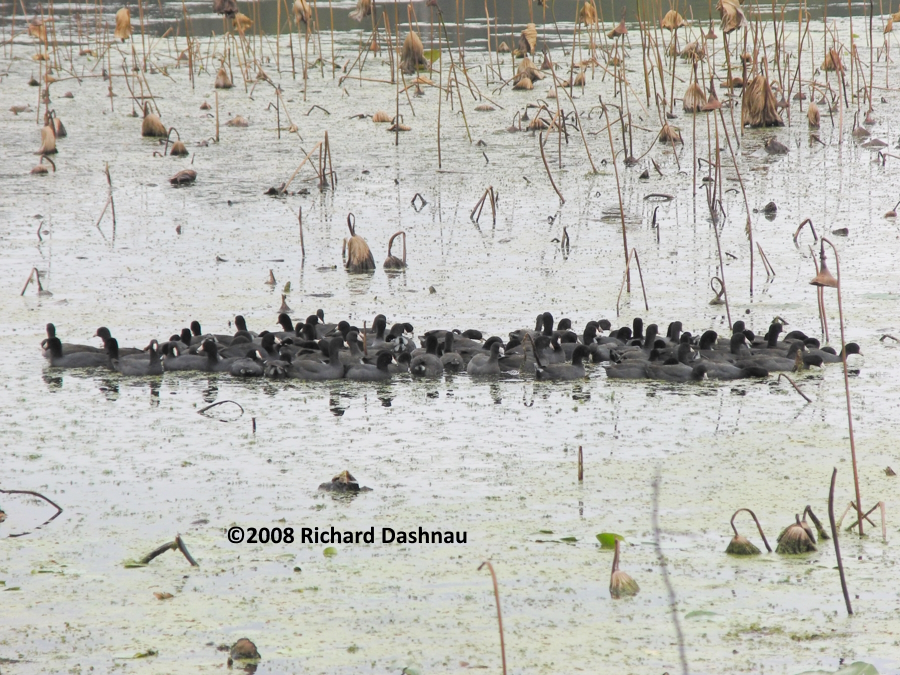 -
-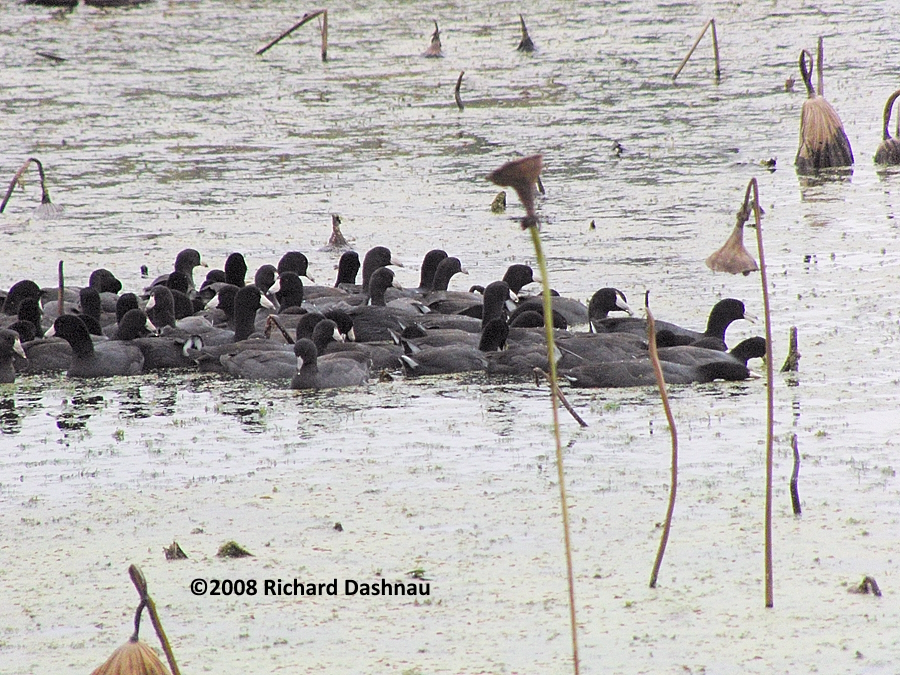 -
-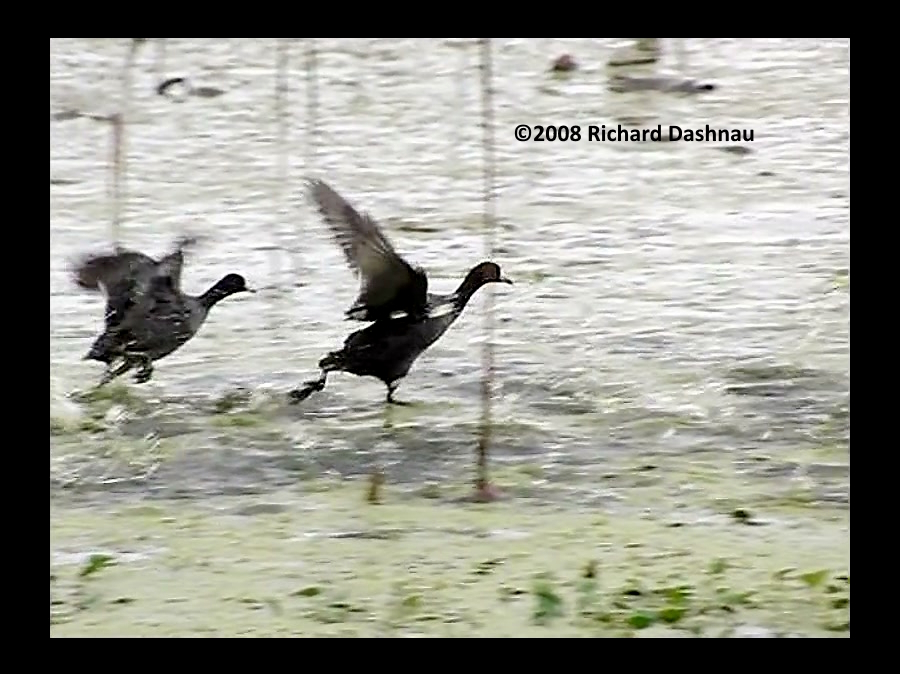 -
-
The wings seem to be used for lift and balance;
with the propulsion provided by the feet and those wide,
spatulate toes. Cones of water were pushed up behind
the Coots from the
thrusts of their feet. Then the Coots merged into another mat at
the next location. I've
made a short video,visible here.
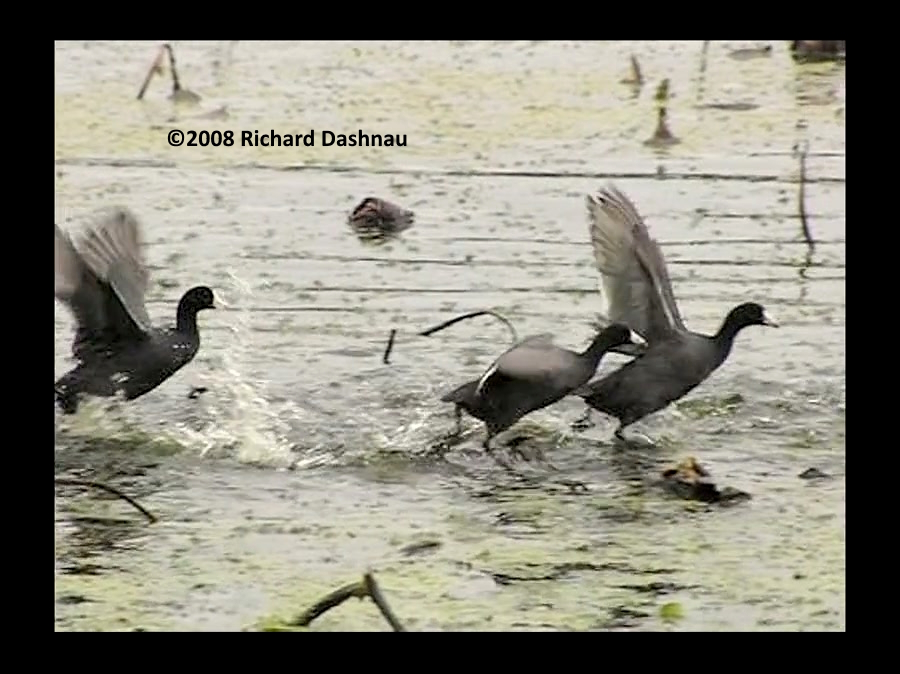 -
-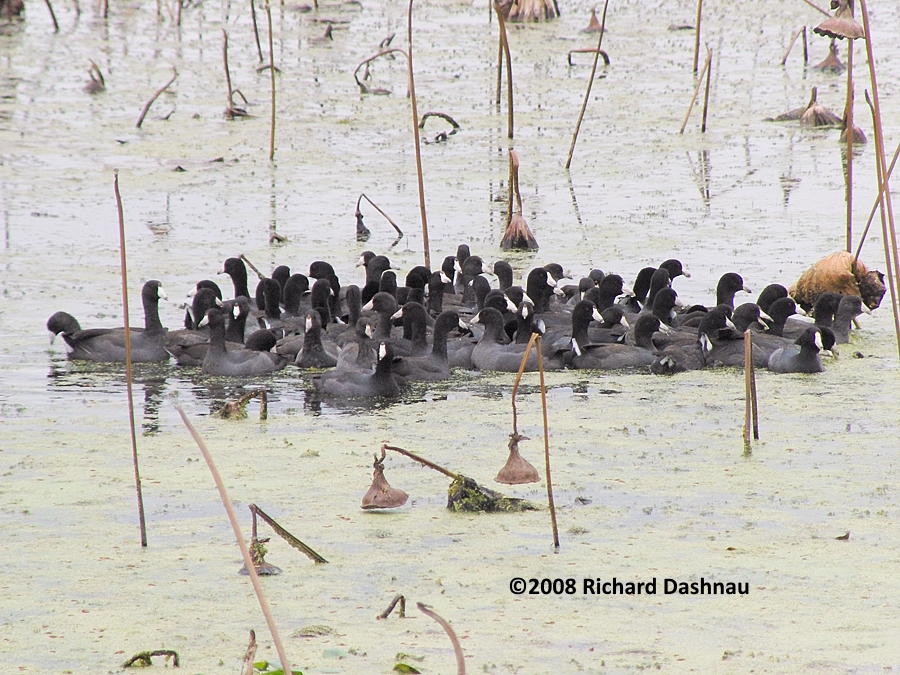 --
--
10/15/2006
(uploaded 1/29/2025)--I
found this group of American Coots standing on the 40 Acre Lake
Trail. When I walked closer, the Coots didn't move. I stepped a
little closer, and
they still didn't move...until the entire flock suddenly
ran/flew (as Coots do) into the lake. I wondered why the Coots
seemed reluctant to move into the lake. And then I noticed
the
alligator in the water--holding the carcass of a Coot. The rest
of the story is on one of my alligator pages.
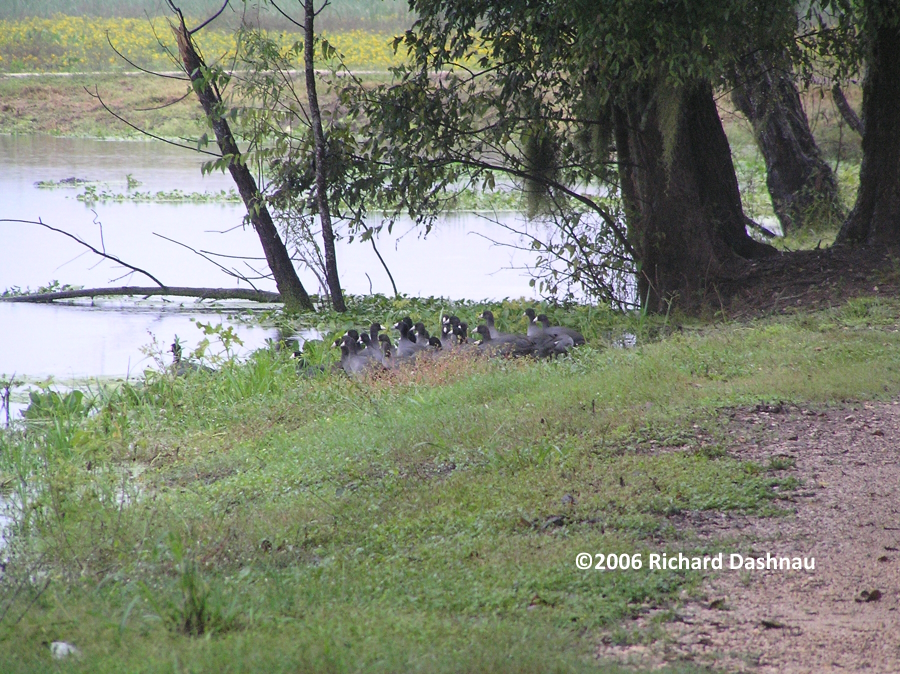 -
-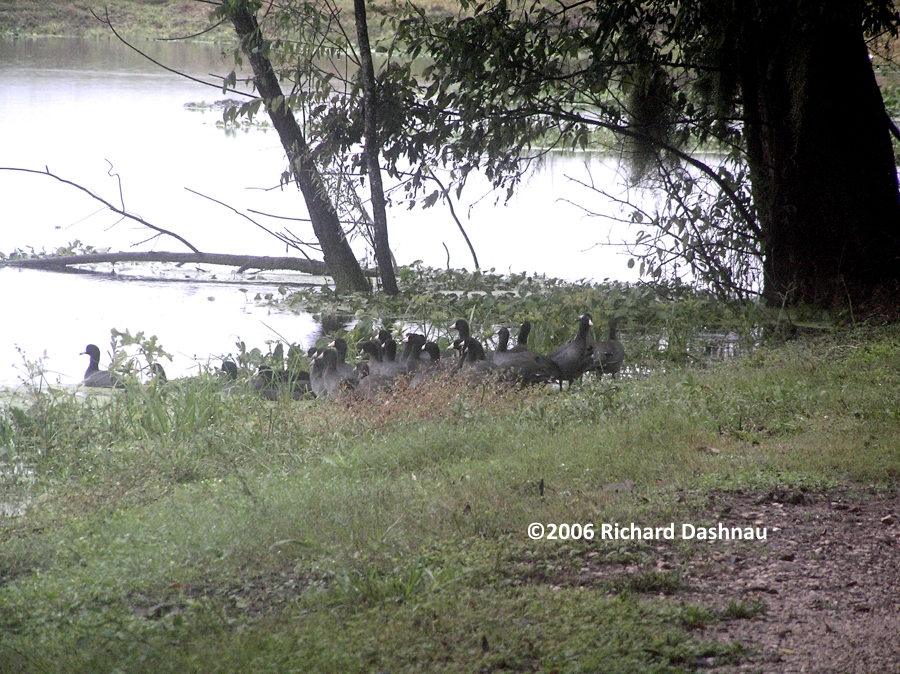 -
-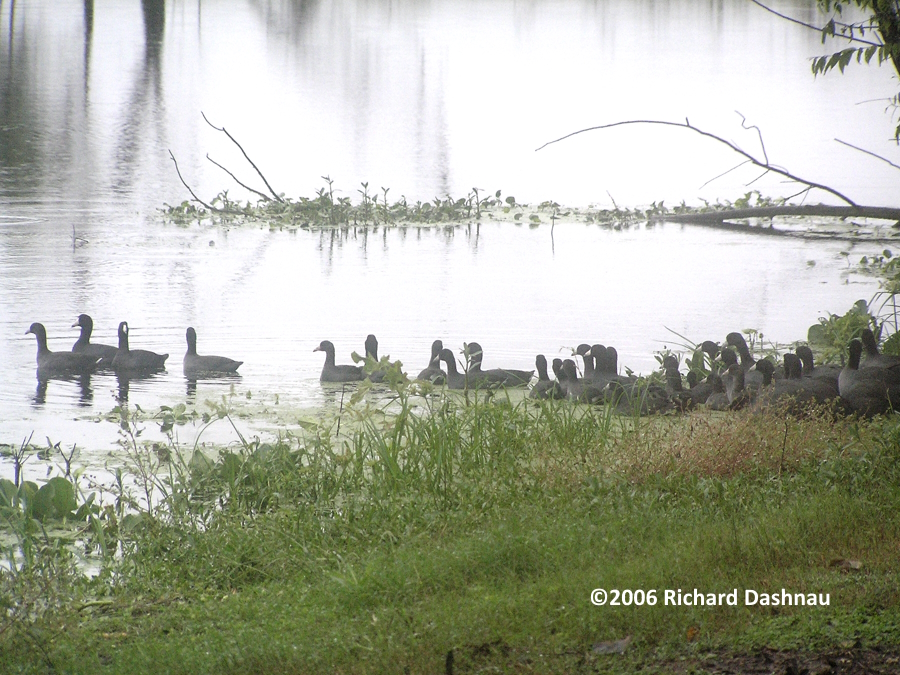 -
-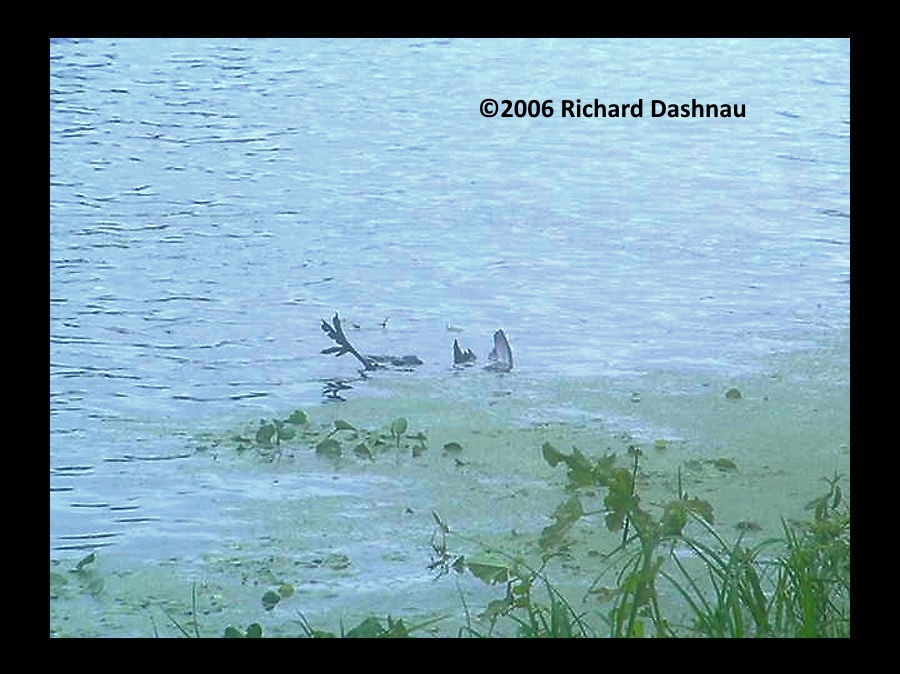 -
-
01/01/2010 Although it's rare, sometimes it gets cold enough
for ice to form on the lakes at BBSP. This was one of those
times. I got just one short clip of these Moorhens walking on
a frozen spot on one of the lakes. The image below is a
frame grab from the clip. The clip can be seen here
(wmv
12.0 mb).
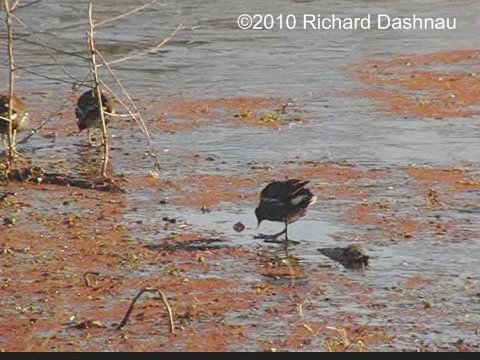
May
15, 2004; I took this
picture of the Purple Gallinule just because they have such
brilliant colors (see Purple Gallinule, below).
-------------------------------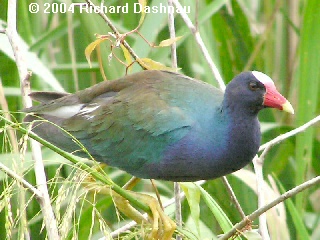
PURPLE GALLINULE
Go back to my
home page, Welcome to rickubis.com
Go back to the RICKUBISCAM
page.
Go back to the See
the World page.

















































 -
- -
- -
- -
-
 -
- -
- -
- -
- -
- -
- -
- --
-- -
- -
- -
- -
-
